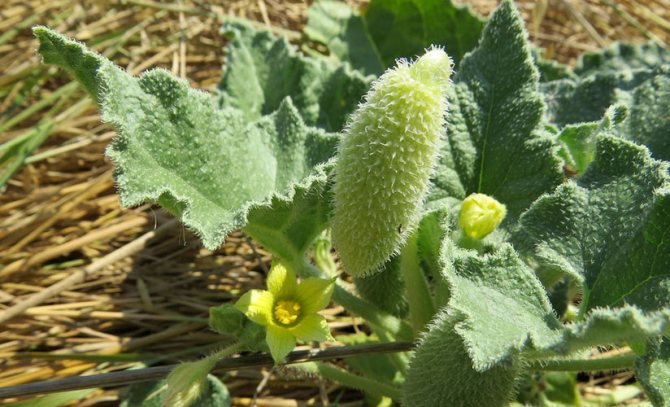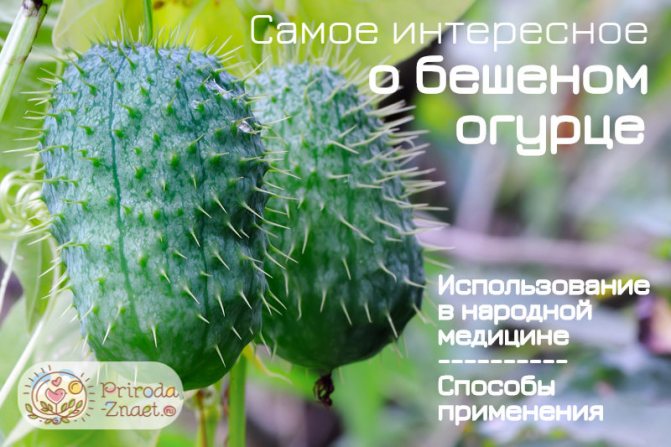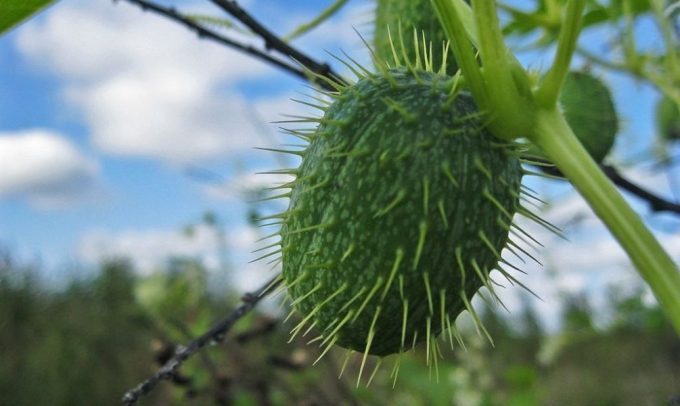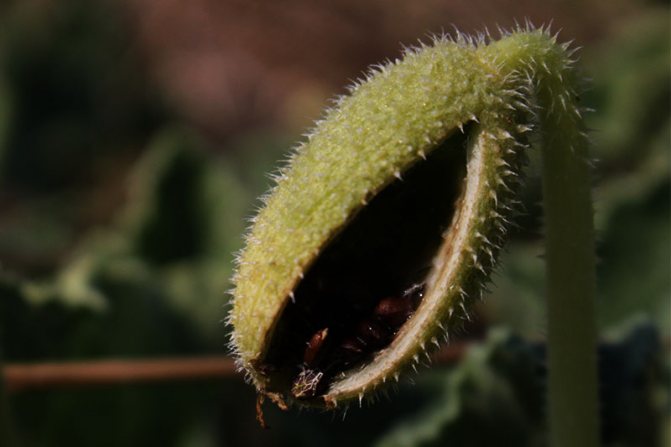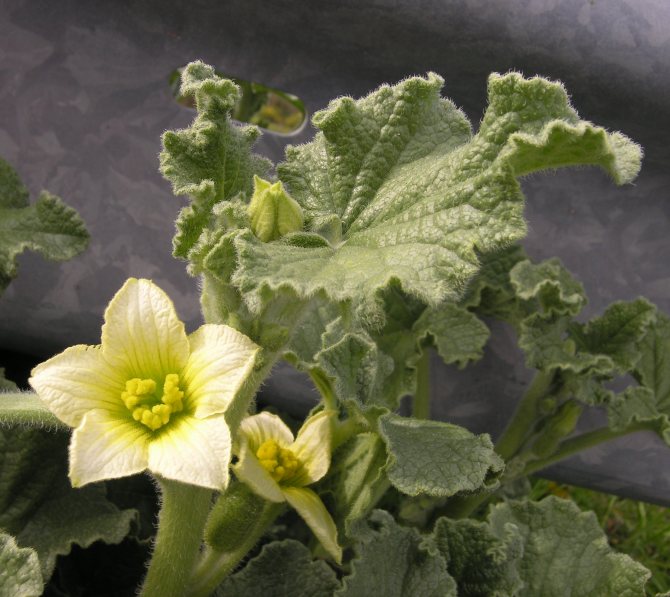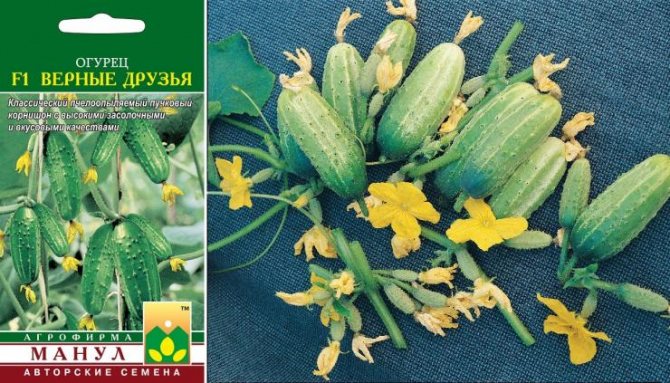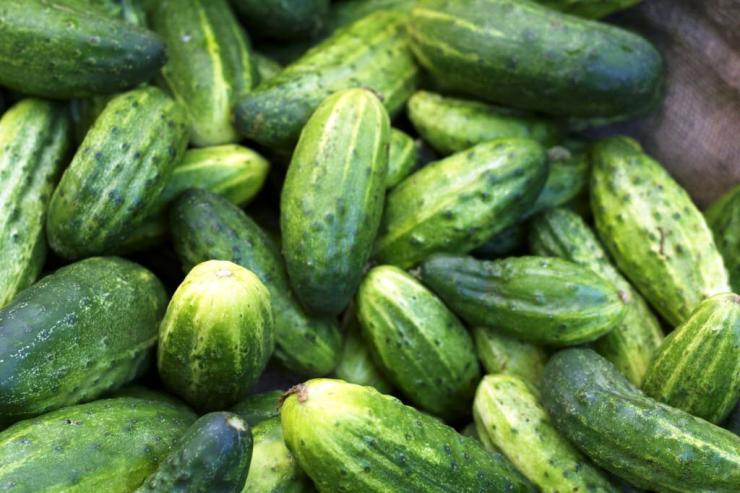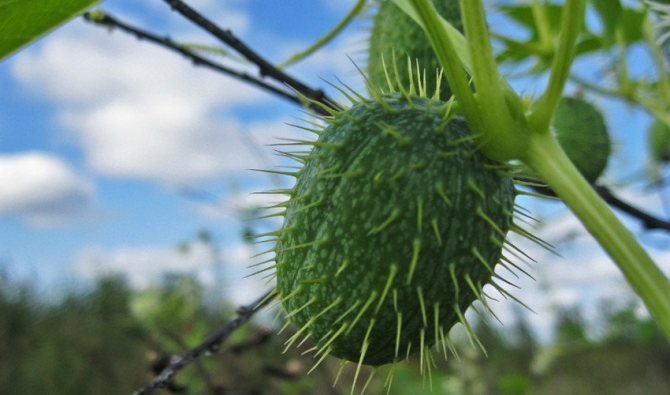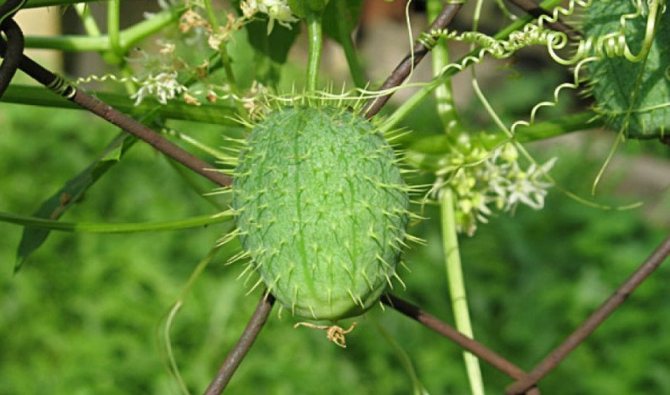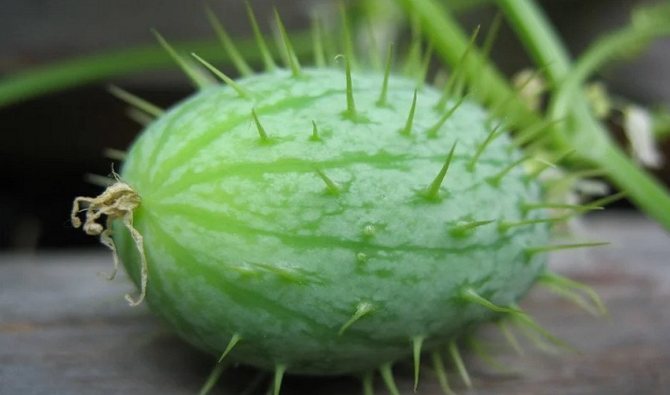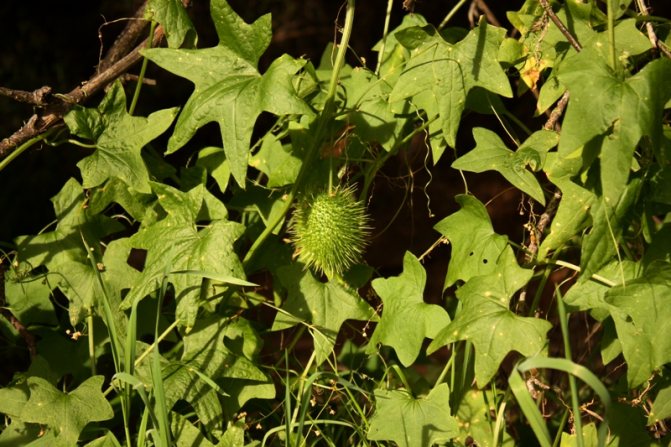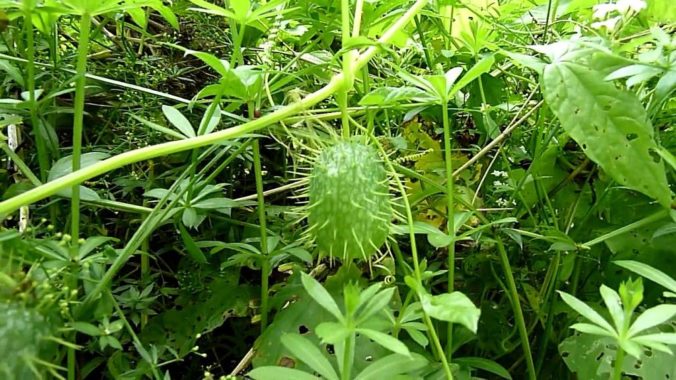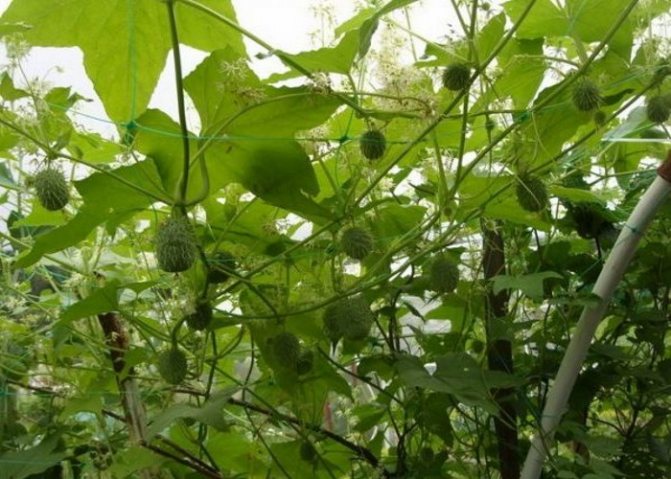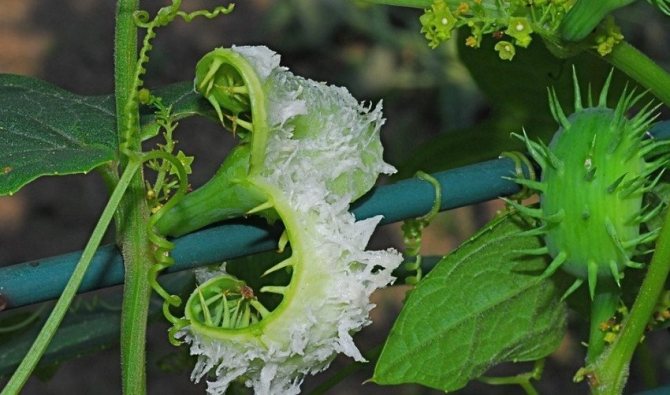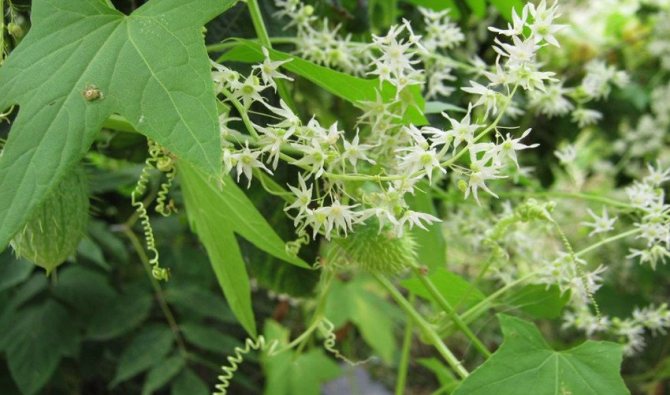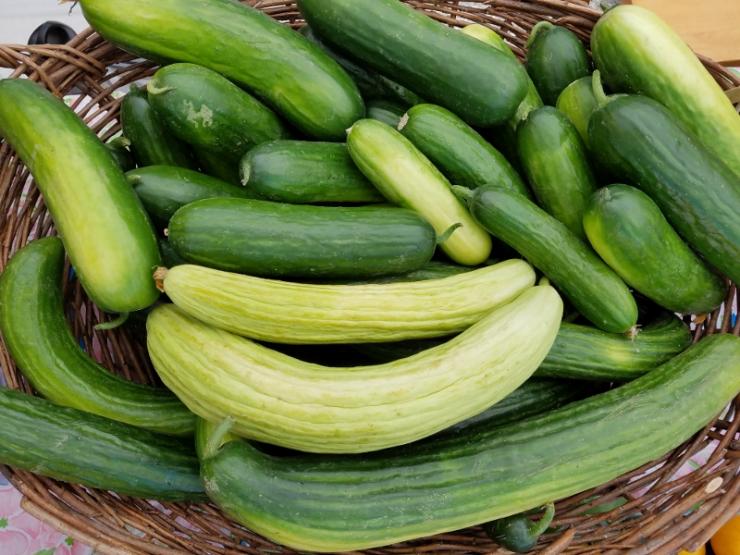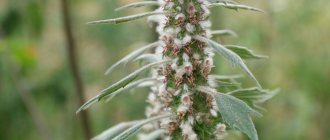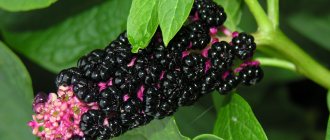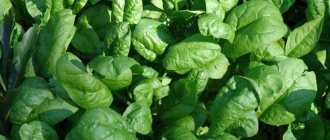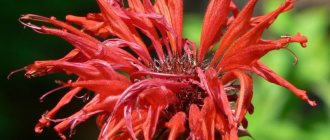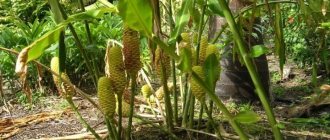"Crazy Cucumber" is the informal name for several plants in the Pumpkin family. Our fences, trees, shrubs and hedges are often covered with the annual Echinocystis lobata. He is unpretentious and quickly develops any territory where the seed is. Is it worth fighting a fast-growing annual herbaceous vine as a weed or letting it grow on the site? After all, it is really decorative. Is it safe to use echinocystis lobe as a medicinal plant or to consider it poisonous?
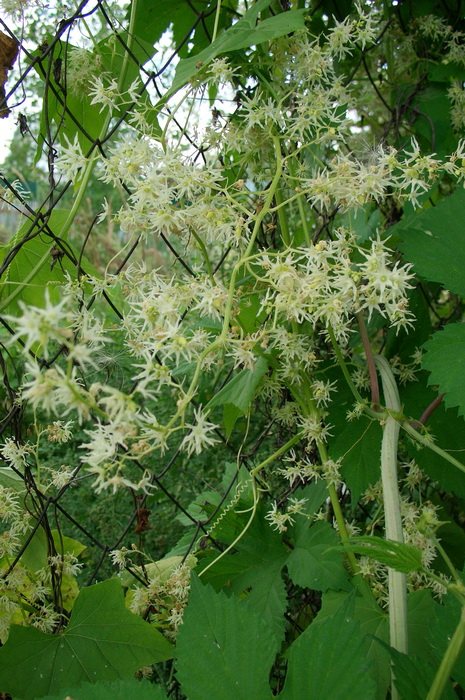
Echinocystis lobed, known as "mad cucumber"
Why did "mad cucumber" get this name?
Echinocystis lobed, or lobed, prickly
, belongs
family Pumpkin
... Popularly, this annual plant is better known as "mad cucumber". The name of the plant comes from the Greek words "hedgehog" and "bubble". The peel of the "cucumber" is covered with soft thorns, therefore echinocystis is also called "
prickly
»
Echinocystis seeds were brought to Europe from North America. There, the plant felt at home and spread to the Far East. It can be found in nature not only along river banks, along roads, but also in forests.
Leaves
... Light green leaves of prickly fruit are slightly rough. They are more often three-bladed or five-bladed. Stems up to 6 meters long cling to any support with tenacious antennae spirals.


Echinocystis lobed leaves ("mad cucumber", prickly fruit)
Flowers
... The fragrant flowers are small, white or light cream. They are collected in clusters of inflorescences. The aroma is delicate, honey. Flowering lasts from July to August.
Inedible pot-bellied prickly "cucumbers" (up to 6 cm long) appear from the end of summer. At first, they have a bluish tint. Inside there are only two cavities with two seeds each. Seeds are shot from a ripe "cucumber" under the pressure of accumulated moisture and mucus, stronger in damp summer. They scatter several meters in different directions. The dried fruit resembles a tiny loofah.


The fruits of the "mad cucumber" against the green wall of the old barn
Seed collection
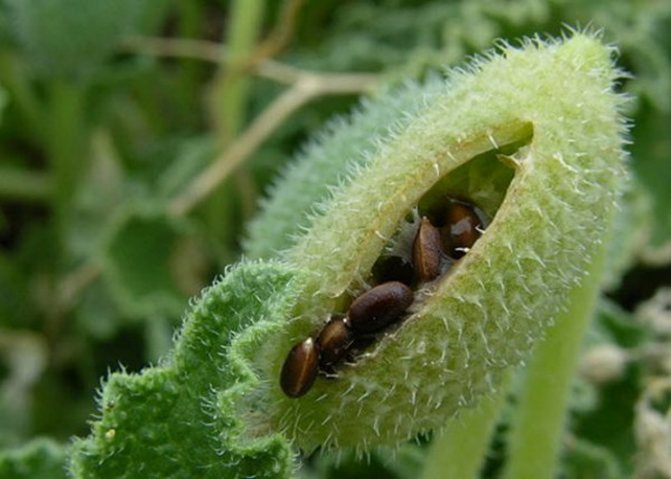

Collect the seed pods in September. After a couple of weeks, they will open and you can pick up the seeds. They are dried for 3-4 days and placed in paper bags in which they can be stored.
Fruits are harvested not only for planting new plants, but also so that sprouts do not appear in an unnecessary place. By shooting seeds several meters away, the rabid cucumber can expand its territory, from where it will be difficult to remove them later. Therefore, weeding several times a month does not hurt.
Growing and decorative
Echinocystis prefers light soils. Doesn't like sour. It grows not only in well-groomed areas, but also in wastelands. You can often see shrubs braided with thorns. Especially along the rivers. "Crazy cucumber" feels great in a sunny place, not bad in partial shade.
It is a cold-resistant plant that grows well in a fairly warm, but not very hot summer. The "mad cucumber" does not attract pests.
An unpretentious fast-growing plant is as decorative as possible during flowering.It can be safely used in the design of a wide variety of vertical structures. The competitor braids fences, pergolas and is able to hide unsightly places on the site.


Flowers of "mad cucumber", collected in inflorescences, beautiful and fragrant
For many people, the scent of flowers causes headaches and weakness. In this case, echinocystis is not the best plant for decorating gazebos or verandas. It is not recommended to be near him for a long time.
Children love green "hedgehogs" with which they can play and make dolls, animals, etc. out of them.
Male flowering type
The stamen type of flowering is characterized by the fact that it does not contain ovaries. The description of their appearance indicates that the flowers are characterized by a yellow color and are on a long pedicel. If we consider male flowers from the point of view of the biological component, then their main purpose is the pollination of female-type flowers, after which the formation of the fetus begins. Pollination is necessary so that fruits can form. This means that the crop will ripen in a short time.
Parthenocarpic cucumber grows without pollination. But, in this case, they completely lack seeds. In order to be able to collect seeds, parthenocarpic inflorescences must be constantly pollinated with male pollen.
The description indicates that male inflorescences most often begin to form on the main stem or lateral shoots. It is believed that most of this formation occurs in beams. The pollen of the male inflorescence is rather heavy. Despite this, it does not fall out of the main flower, because the stickiness characteristic very strongly holds it in its place. For this reason, the wind cannot carry the pollen, and pollination is possible only with the help of bees or other insects.
Reproduction
"Crazy cucumber" is a monoecious plant. It reproduces by tough, oblong-oval, dark seeds, reminiscent of watermelon seeds. Each "cucumber" contains four seeds, the germination of which is very high.
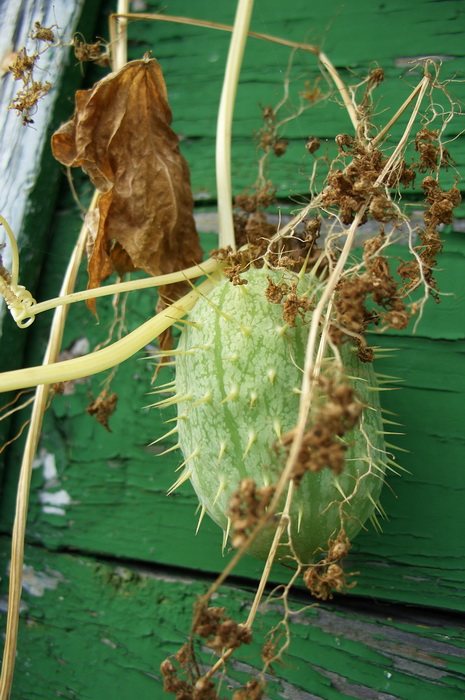

Crazy Cucumber Spiny Fruit
Sowing is best done in autumn, the year of seed ripening. Seed storage reduces the germination rate.
Seedlings appear quickly and begin to rapidly climb up any support. Outwardly, they look like cucumber or squash. Our first "mad cucumber" was successfully transplanted by me from a vacant lot to a fertilized garden bed. Many years have passed since then. Now this loach is registered on the site, weeds and germinates in places where it is not visible at first.
Preparing a spring greenhouse for growing cucumbers
In spring greenhouses, cucumber is grown on soil with the addition of organic and mineral fertilizers. To prepare the greenhouse for cucumbers in the fall, 25-30 kg of manure, 45-60 g of superphosphate, 20-30 g of potassium sulfate per 1 m² are introduced into the soil. After that, the soil is dug up. In the spring, before loosening, add 25–35 g per 1 m² of ammonium nitrate.
Every year they improve the water-physical properties of the soil by introducing loosening materials (straw cutting, sawdust, peat) up to 25% of the volume. When straw and sawdust are introduced in the spring, nitrogen fertilizers are additionally added to compensate for nitrogen, which has been absorbed by the rapidly developing microflora, at the rate of 30 g of nitrate per 1 kg of sawdust and straw.
Seedlings of short-fruited cucumber hybrids are planted in spring greenhouses when the soil at a depth of 10 cm at 8 o'clock in the morning warms up to 14 ℃. In heated spring greenhouses, this happens in the first or second half of March, depending on the heating capacity. In unheated greenhouses in the steppe zone, cucumber is usually planted in mid-April, in the forest-steppe zone and Polesie - in the third decade of April. These dates coincide with the transition of the average daily air temperature through 10 ℃. Seedlings of hybrids with an elongated fruit shape should not be planted in soil at temperatures below 10 ℃.In cold soil, it forms a weak root system, small leaves are affected by diseases. Inexperienced vegetable growers go to the other extreme, being late with the dates of planting, planting in greenhouses in May at the same time as planting in open ground. This leads to the loss of an early harvest. Remember that greenhouses are expensive structures and they must be recouped first of all with an early harvest.
The greenhouse is covered with foil 10-15 days before planting the seedlings and heated in advance, if possible, in order to set the required air and soil temperature.
In greenhouses, it is very important to ensure the productive work of the bees. Poor pollination leads to a sharp decrease in plant productivity, increased growth of side shoots, which increases labor costs for the formation of a bush. 5-7 days before flowering, one hive is set on 1000 m². When growing parthenocarpic hybrids, the presence of bees in greenhouses is not allowed, since they reduce the quality of products by pollination - fruits with seed heads are formed. Therefore, it is impossible to grow parthenocarpic and bee-pollinated varieties in the same greenhouse, with the exception of a number of hybrids - F1 Matryoshka, F1 Maryina Roscha, F1 Ant, etc., in which pollination does not impair product quality.
Weed or not?
The lobed prickly plant is actively exploring new regions, often running wild, finding itself in abandoned territories or in nature.
At our site, "mad cucumber" has become. I don't like the fact that Echinocystis grows quickly among the hops. Many long shoots, light green foliage and whitish inflorescences spoil the overall impression of the hop wall with beautiful dark green foliage and armfuls of golden honey "cones". It is worth missing the moment, and the whips of the prickly plant climb onto the branches of trees and bushes. Even hedges of carefully selected shrubs suffer from the "mad cucumber".
"Crazy cucumber" on a hazel (hazel) bush
The neighbors also suffer with this plant, which from time to time sprouts among the maiden grapes.
It is said that the milk of cows and goats, which often ate "mad cucumber", can taste bitter.
What are the roots, stems and flowers of cucumbers (with photo)
The assortment of vegetable crops in greenhouses includes about 50 fruit, leaf, root, onion and other crops.
Cucumber is one of the favorite and popular vegetables. Everyone loves its aroma, crunchy flesh, delicate taste.
Cucumber contains many alkaline compounds that neutralize acidity. Cucumbers are very good for improving the functioning of the stomach, kidneys, liver, heart, removing cholesterol. Easily assimilated iodine in cucumber normalizes the thyroid gland. Regular consumption of fresh green leaves reduces the formation of carbohydrates and fats in the body. Arrange cucumber fasting days - and become slimmer. Sensation: Cucumbers contain silver. Eat more cucumbers and your value will increase!
Cucumber - native to the tropical regions of India; it is a gentle warm and moisture-loving plant.
Seeds begin to germinate at 12-13 ℃, however, under these conditions, seedlings appear very slowly and rarely. The optimum temperature for seed germination is 25–30 ℃, then they sprout 4–6 days after sowing. For normal growth, a temperature of 25-27 ℃ is required. At temperatures below 15 ℃, the development of plants is delayed, at 8-10 ℃ they get sick, and at 3-4 ℃ they die after 3-4 days. The cucumber does not tolerate frost. Young shoots (in the phase of cotyledons) are most sensitive to cold. In the phase of one or two true leaves, when intensive photosynthesis begins in plants, their resistance to cold increases significantly. The optimum temperature for flowering and fertilization of flowers is 18–21 ℃. The best temperatures during the fruiting period are 30–32 ℃ during the day and 20–22 ℃ at night.
When grown, cucumbers of all varieties need high soil and air humidity (85–95%) in combination with high temperatures (like the atmosphere of a bath).This is due to the weak development of the root system, its low sucking power, large evaporating surface of plants, high tissue water content and the intensity of transpiration. With insufficient soil moisture and low relative air humidity, plants grow poorly, develop slowly, the first, most valuable ovaries fall off, few fruits are formed, they do not reach normal size, and their taste is low. Lowering the temperature and humidity of the air contributes to the appearance of bitterness in the fruit. The cucumber suffers from fluctuations in day and night temperatures, drafts, and cold watering. It is enough to pour cold water once, so that diseases appear in 10-15 days.
One of the features of growing cucumbers is to provide these plants with enough light.
Cucumber is picky about the fertility and structure of the soil, is unstable to salinity, it is also very sensitive to a high concentration of soil solution and to soil acidity (the optimal pH level is 6.2-6.8).
As you can see in the photo, the root of the cucumber is pivotal, it penetrates the soil shallowly, and has numerous branches:
Knowing what the root of a cucumber is, it is important to provide good conditions for its development and very carefully loosen the soil around the plants; it is best to do the pricks with a pitchfork.
And what is the stem of a cucumber and what is the intensity of its branching? The length of the stem, depending on the variety and culture, varies from 30 to 500 cm or more. Greenhouse hybrids have a strong growing lash. They vary greatly in their branching tendency. There are hybrids in which branching begins after the pinching of the apical bud. In others, branching begins after harvesting the fruits from the main whip. In the presence of self-regulation of branching, less time is spent on pinching the lateral shoots. The rarest hybrids are those with shortened internodes, which practically do not require pinching.
The intensity of branching has not only a genetic basis, but also depends on external conditions. Shading, low temperatures, and lack of water contribute to the reduction of branching.
Look at the photo - the flowers of a cucumber are single, as a rule, dioecious:
One plant contains male and female flowers. Usually male flowers are collected in inflorescences of 5-7 pieces, the first ones appear in the lower nodes of the whip, and female flowers are located singly, rarely 2-3 in the leaf axil, appear later.
The manifestation of sex is a varietal trait, but it may also depend on external conditions. A decrease in temperature, carbon monoxide, and a decrease in the length of the day to 12 hours accelerate the formation of female flowers and increase their number.
Now hybrids are being created with a female or predominantly female type of flowering, in this regard, there is no need to use techniques that contribute to an increase in the number of female flowers. Along with this, there are varieties with a male flowering type used as pollinating plants. Cucumber is a cross-pollinated plant. At the same time, hybrids with parthenocarpic fruit formation are very popular in greenhouse vegetable growing. They do not require pollination. It is valuable that the formation of the crop does not depend on pollinating insects, which are not always willing to visit the greenhouse. When pollinated, such hybrids give seeds, but at the same time, in most long-fruited varieties, marketability is lost, since the greens acquire a deformed clavate shape.
Hybrids differ in the manifestation of parthenocarpies, which largely depends on the growing conditions. A relatively short day, high illumination, increased CO2 content, and optimal nutrition contribute to the strengthening of parthenocarpies. There are partially parthenocarpic hybrids that exhibit this ability only under favorable conditions.
Parthenocarpic hybrids are: short-fruited (green leaf length up to 20 cm), relatively short-fruited (green leaf length - 20-22 cm) and long-fruited - 25-30 cm or more. The surface is smooth and lumpy. The highest early yields in winter greenhouses are provided by smooth, long-fruited cucumbers. A somewhat unusual appearance does not detract from the high taste.
The use of "mad cucumber" in traditional medicine
Inedible "cucumbers" contain toxic substances. Traditional medicine only with great care allows the use of some parts of the plant (after preliminary preparation of raw materials) for medicinal infusions and decoctions. The prickly fruit contains toxins that can harm the human body. Therefore, you should not take risks and bury fruit juice in the nose with a cold, although they write that this method of treatment really helps some people. Herbalists advise pre-diluting the juice with water.
I would not let the kids play with the funny fruits of this plant, because there are known cases of damage to the delicate skin with fresh juice of the prickly fruit.
R.B. Akhmedov, a practicing folk healer and plant connoisseur, warns:
«The plant is poisonous, requires careful handling. Crazy cucumber is contraindicated in pancreatitis, diseases of the stomach and intestines with a tendency to loose stools, during pregnancy, as well as people with a weak heart. Use the juice and infusion of the herb only according to the recommendations of herbalists
"(The book" Plants are your friends and foes ").
Self-medication can be dangerous. the properties of this interesting plant have not yet been studied.
Exotic cucumbers (32 photos)
Let's talk today about cucumbers. More unusual than ordinary. No, no, about the cucumbers that are from the garden and immediately into the dupa, we will not say anything. So…


0
See all photos in the gallery


0
Most cucumbers are native to the tropics, but they quickly take root in colder regions, yielding fairly high yields. In contrast to the traditional Russian cucumber, moderately long, green, with pimples, exotic varieties in the process of "evolutionary" development have acquired different species, which in appearance have acquired similarities with some vegetable and fruit crops. They have a wide range of colors: from white and marble to yellow, orange and even red. I don't even mention the green ones. In size and shape, they can be as tiny as pickles and gherkins, or they can hang down like serpentine fruits up to a meter long. And have unusual taste.
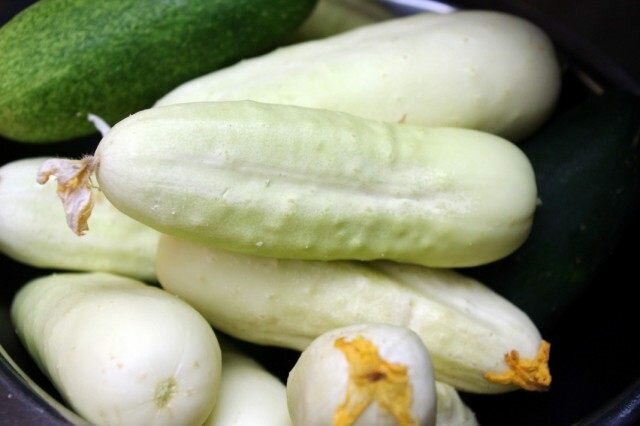

0
White cucumber. White cucumbers are practically the same ordinary green cucumbers, only albinos, naturally selectively bred. But there is still a slight difference. First, there is a difference in the color of the fruits. Secondly. Taste differences boil down to the absence of bitterness and the presence of a richer aroma. Thirdly. Strong growth of the lashes of the plant. Fourth. Undemanding to the formation. And fifthly, I think the most important point. They are resistant to changes in weather conditions, lower and higher temperatures, they tolerate shading well.


0
They can withstand hot weather up to + 45 ° С, are resistant to diseases and pests. Fruits up to 20 cm long are formed. Small fruits of 8-12 cm are used for food. The flesh of a white cucumber is tender, sweetish in taste. It is considered a delicacy among cucumbers.


0
Chinese serpentine. Appeared on the Russian market, this cucumber about 10-15 years ago. Adapted to growth both in a lighted and shady area, unpretentious to temperature extremes. Outdoors, it bears fruit until mid-autumn, even at night temperatures of + 6 ° C. It grows very quickly. It has a thin elastic skin with large tubercles, dense, juicy, sweetish, without bitterness and without voids. And all this is accompanied by a delicate aroma. "Cucumbers" reach a length of 40 to 85 cm.


0
But at the wrong time, the harvest will "please" with the appearance of real snakes, which will reach up to 90 cm in length and more.So you can completely fill a salad bowl with one cucumber. They are used not only fresh, they can be used to prepare winter preparations - pickling and salads. But it is not suitable for salting.


0
Kiwano. Kiwano is an exotic fruit native to Africa. It is also called the African cucumber, English tomato or horned melon, since on the surface of this oval-shaped fruit there are thorns in the form of horns. Kiwano is a herbaceous vine of the pumpkin family, the subspecies is a cucumber.


0
Its peel is yellow-orange in color, and the pulp is jelly-like with a tart taste. This fruit has a versatile composition. It contains water, carbohydrates, proteins, fats. In addition, the fruit is rich in vitamins A, B, C, as well as macro- and microelements (iron, calcium, zinc, potassium, magnesium, manganese). Kiwano is considered a low-calorie product, therefore it is used for dietary nutrition. Seedlings are transplanted into the beds after there is no frost on the soil. When transplanting a plant to open ground, you should choose a place that will protect the seedlings well from wind and direct sunlight. Although this exotic cucumber is considered thermophilic, it cannot stand the hot sun. Burns quickly develop on the leaves, and the ovary and flowers may fall off.


0
Kiwano loves loose, light and permeable soil. Drought and excessive moisture are detrimental to him. If you want to eat the fruit immediately, as soon as it has been plucked, then you should discard all the seeds, and select all the pulp with a spoon. The peel of this cucumber is not eaten, it is too tough. But there are those (and there are quite a few) who, for the sake of vitamin B and fiber, still prefer to use the peel of the exotic. Thus, the cultivation of such an exotic fruit from seeds in our country is within the power of everyone.
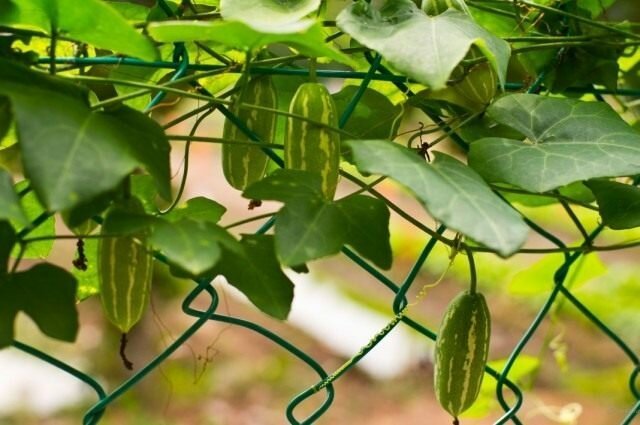

0
Melotria rough. Melotria rough is a native of equatorial Africa. This plant is annual, its stems reach a length of 3 m. They call melotria and mini-cucumber for the miniature size of the fruits (1.5-2.5 cm) and mouse melon, and hummingbird cucumber, and African cucumber, even sour gherkin.


0
Its fruits, similar in color to small watermelons, are very tasty. In addition, African cucumbers have many health benefits. In taste and use, they may well replace ordinary cucumbers. Used for salads and processing (salting, canning). Melotria fruits contain a lot of fiber. They are rich in protein, fat and carbohydrates. They also contain minerals such as magnesium, iron, potassium, calcium, phosphorus, sodium. In addition, vitamins B9 and C are part of African cucumbers.


0
Melotria cucumbers should be eaten when they are still young. Ripe fruits with thick skin must be pickled or salted. But what is interesting is that not only fruits are edible in melotria, but also tubers. They taste like cucumber and radish at the same time. You need to use the tubers immediately after digging them up, because they are stored for a very short time. Melotria tubers can be used to prepare salads and vegetable stews. Melotria in central Russia is grown as an annual ornamental crop and can serve as a green hedge.
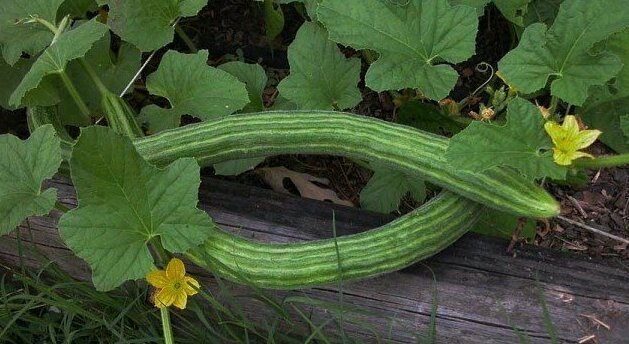

0
Armenian cucumbers Armenian cucumbers are also called silver melon. The plant is a type of melon. It is widespread in China, Japan, Uzbekistan and Italy, which characterizes the serpentine melon as a thermophilic culture, for which the presence of high temperature indicators of soil and air, as well as good lighting, is very important.
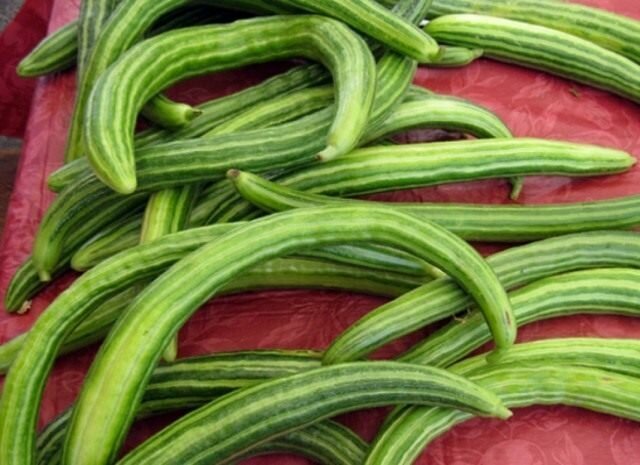

0
This is a melon culture that is still little known to gardeners. Fruits are light green, covered with soft silvery pubescence. The length of the fruit varies from 45 to 50 cm. The peculiarity of the Armenian cucumber is the complete absence of an air cavity inside it. Armenian cucumbers are easily cultivated in open and protected ground. Caring for a cucumber consists in regularly loosening the soil and, with infrequent, but quite abundant watering.It is required to monitor the cleanliness of the plantings and regularly weed. It is recommended to use organic fertilizers as fertilizers. They do not get sick, are resistant to temperature extremes. They are distinguished by long-term continuous fruiting almost to the very frost.
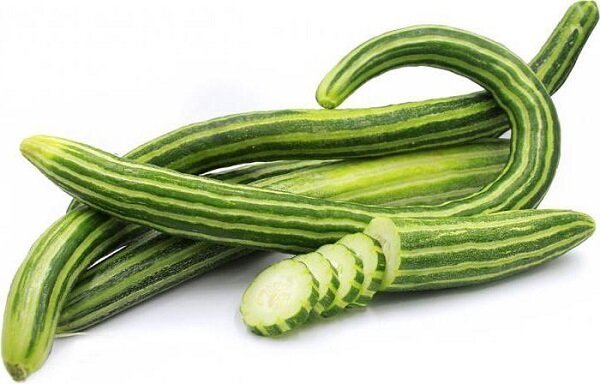

0
The taste is somewhat peculiar, designed for the amateur. Some fans of exotic vegetables believe that they taste like pumpkin, others compare them to melon. The taste and color, as they say ... Armenian cucumbers are eaten fresh together with the peel, and can also be used for salting and canning. As a result of overripening, the fruits turn yellow and almost completely lose their taste. Fruits contain about 13-14% sugars, about 15% dry matter and 7.5% starch. In addition, the pulp is rich in vitamins and mineral salts.
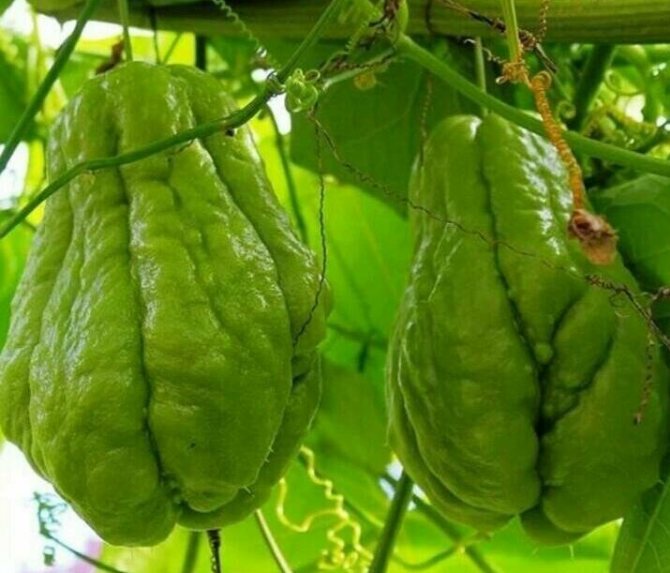

0
Chayote is a Mexican cucumber. Chayote is native to Central America. In nature, the Mexican cucumber is a perennial vine that can grow in one place for up to 20 years. With the help of antennae located at the ends of the shoots, it clings to the supports. The stem itself grows in favorable conditions up to 20-50 meters in height. Over the years, both the stem and antennae coarsen, and the stem grows woody, turning chayote into a resistant and strong plant. This is a very interesting specimen. If such a comparison can be applied to a plant, then I would say that it is a "viviparous" plant. Why? It turns out that whole fruits are used for reproduction. They are placed in the soil at an inclination of 45 degrees with the wide side down and 2/3 covered with soil. First, the root system is formed, and then young shoots with leaves appear from the upper aerial part. There are many shoots, so plucking is carried out, leaving 2-3 of the strongest shoots. With its antennae, the plant clings to the support and stretches upward. In order for the plant to bloom, the light period is artificially reduced by covering the plants with an opaque material, because chayote blooms only when the day length is no more than 12 hours.
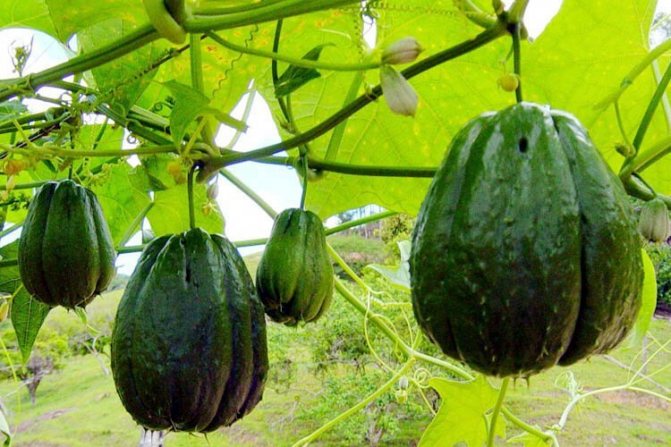

0
Chayote needs special growing conditions: abundant watering with water heated to 25 C, the soil is limed before planting, since chayote does not tolerate acidification and does not tolerate cold soil, the temperature of which should be at least + 15 ° C. In our latitudes, it is possible to grow chayote only under cover. Even approaching zero can destroy its whips and leaves. The optimum temperature for seed germination is + 20C, for the growing season everything is needed + 22-28C, the entire growing season takes 6-7 months. Even under favorable conditions for growing outdoors in southern Russia, Mexican cucumber does not tolerate winters, mainly due to the soaking of tubers.
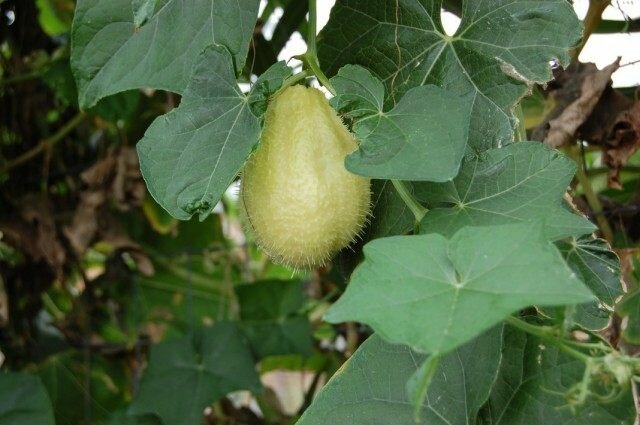

0
Chayote, in terms of its taste and appearance of the fruit, is a more distant relative of Kiwano and common cucumber. Its fruit resembles an unusually large unripe green pear in its shape. The inside of the fruit is juicy, sweetish white flesh. Of the twelve varieties of Mexican cucumber, only three are grown in our country: green, white and prickly species. The lack of culture is large, heavy fruits on a thin stalk, which break off in the wind, are damaged when dropped and quickly deteriorate .. When ripe, the crop is removed carefully, since damaged fruits (as mentioned above) are not stored. With the correct harvest of the fruits, the harvest is stored for up to six months. Cucumbers are harvested in September and stored at +3 .. + 5 ° С. Previously, the stalks are removed from the fruits and dried for several days at room temperature.


0
Cucumber-lemon India has long been considered the homeland of cucumber. Perhaps the only spherical cucumber variety that has taken root in Europe is CRYSTAL APPLE ("crystal apple").In Russia and on the territory of the former USSR, this variety got its second name "lemon cucumber" due to its striking external resemblance to lemon fruits.
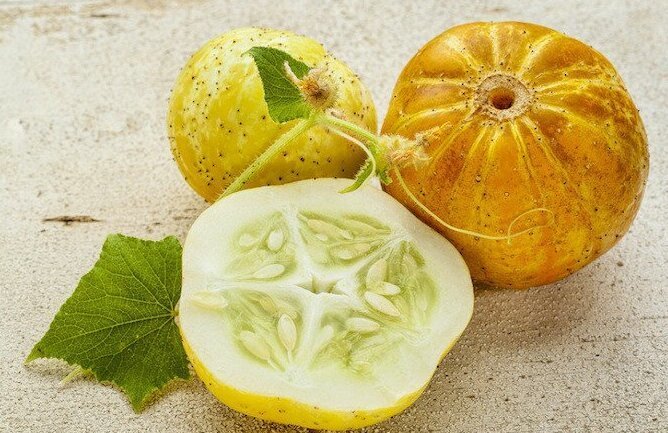

0
But the similarity is purely visual, and the cucumber, of course, has nothing to do with lemon. Therefore, drinking tea with lemon-cucumber is unlikely to work. A distinctive feature of the fruit is the high content of crystal-clear moisture in the pulp. Young cucumbers are light-green in color, and by ripening they acquire a light yellow color, a pleasant aroma and taste.
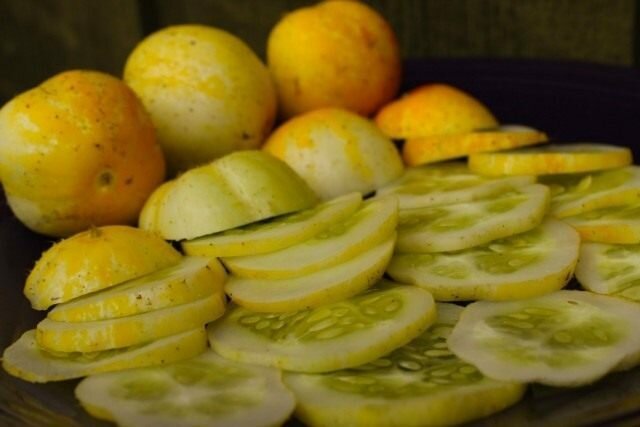

0
The surface of the fruit is covered with a silky fluff. Fruiting until the frost. Use lemon cucumber, both fresh and canned. When processed, the fruits retain their color and shape without changing. The plant is southern, therefore in central Russia it is grown only through seedlings. Lemon cucumber loves moisture and responds well to watering, but it is able to extract moisture from the air and thus wait out the dry season.


0
Momordika. Momordica belongs to Indian cucumbers and is probably the champion of the variety of names. They call Mamordiu and Indian, or yellow cucumber and crocodile cucumber, mad melon and Indian pomegranate, balsamic pear and bitter melon, bitter apple, fragrant pear and bitter gourd. Momordica is a herbaceous climbing liana from the pumpkin family, native to the tropical regions of India and Southeast Asia. It has extraordinary fruits, ripe - similar to exotic bright orange flowers.


0
Fruits change their shape and color during development. Fruits 6-8 cm long resemble cucumbers, and the bumpy surface is a crocodile skin. The resemblance to a crocodile increases with the ripening of the fruit. They gradually change the green color of the fruit to orange. The lower part of the fruit cracks and during this period of time it resembles the open mouth of a crocodile, filled with bright red or bright crimson seeds in a jelly-like pulp. For this amazing resemblance, Momordica got the name "crocodile cucumber". Young fruits taste like a squash, unripe pumpkin and cucumber at the same time. Ripe fruits are sugary-sweet (reminiscent of persimmon) with bitterness from the surface of the fruit. For its peculiar taste, the fruits are used only by lovers of exotic vegetables.


0
Momordica can be grown in a greenhouse, a greenhouse, on a balcony and in a room on a windowsill. Basically, the plant is propagated with seeds, but the method of propagation by cuttings is also used. Before fruiting, the leaves and stems of momordica cause skin burns when touched, like nettles. It is recommended to harvest momordica fruits on the 8-10th day after their appearance, then they do not yet have a bitter taste. It is known that in ancient China there is a momordiku that was allowed only to the emperor and his family members. In India, it was considered a plant of the gods, in Japan - food for long-livers.
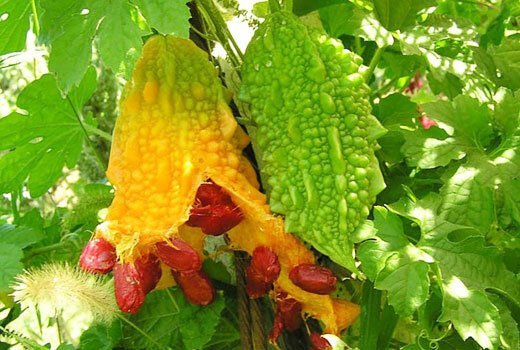

0
In our country, this exotic cucumber can be tasted in Korean stores. But our avid gardeners believe that growing momordica on their own is much more interesting. Some varieties of Momordica are grown as ornamental houseplants, while others are grown as vegetable garden crops or as ornamental plants along fences and arbors. Ripe fruits are sugary-sweet (reminiscent of persimmons) with bitterness from the surface of the fruit. For its peculiar taste, the fruits are used only by lovers of exotic vegetables. Momordica can be grown in a greenhouse, a greenhouse, on a balcony and in a room on a windowsill. Before fruiting, the leaves and stems of momordica cause skin burns when touched, like nettles. It is recommended to harvest momordica fruits on the 8-10th day after their appearance, then they do not yet have a bitter taste.


0
It is known that in ancient China there is a momordiku that was allowed only to the emperor and his family members. In India, it was considered a plant of the gods, in Japan - the food of centenarians.In our country, this exotic cucumber can be tasted in Korean stores. But our avid gardeners believe that growing momordica on their own is much more interesting. Some of the Momordica varieties are grown as ornamental houseplants, while others are grown as vegetable garden crops or as ornamental plants along fences and arbors.
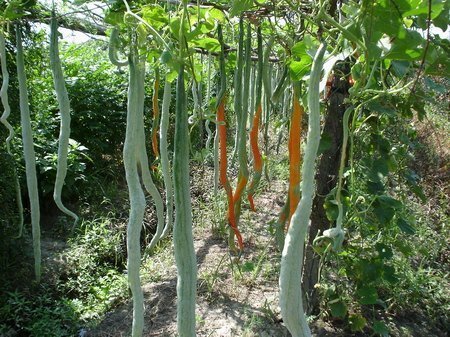

0
Trichozant Trichozant, or serpentine cucumber, is a thermophilic plant native to Southeast Asia. It got its name for the external shape of the fruit, resembling wriggling snakes of dark green color, which eventually change color to a bright red-orange color. In length, the fruits reach 1.2 meters. Trichozant serpentine is an unusual plant, the fruit of which is a vegetable similar to a cucumber and a pumpkin. The popularity of this plant has been growing over the years. In our latitudes, it is very rare, so they began to grow it artificially.
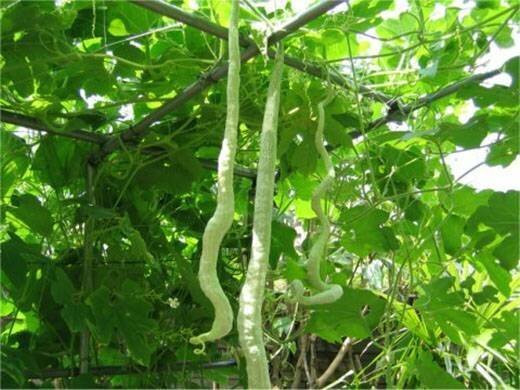

0
Now it is grown in China, India, South America and even in some parts of Russia. In the regions of Russia, Trichozant is not widespread; it is grown mainly by lovers of exotic plants because of its decorative effect. Basically, Trichozant grows in open ground only in the southern regions. In the middle lane, this is a greenhouse plant. At temperatures below 10C, the plant dies.
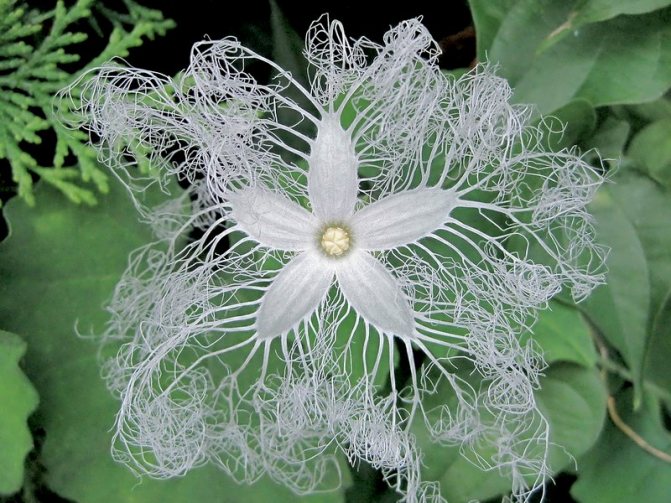

0
Like other species, Trichozant is unpretentious in care. The flowers of the Trichozant are very unusual: small, no more than 4 cm, they resemble snowflakes. Fresh unripe fruits are always green, while ripe fruits can be green, yellow, orange and even fiery red, resembling pumpkin in color. Serpentine cucumber is quite a valuable product due to its chemical composition. It contains many minerals and vitamins, while the calorie content of the product is low, like a regular cucumber. The seeds in the fruit are large, like in a pumpkin. The fruits are eaten, mostly raw. They can also be stewed and fried.
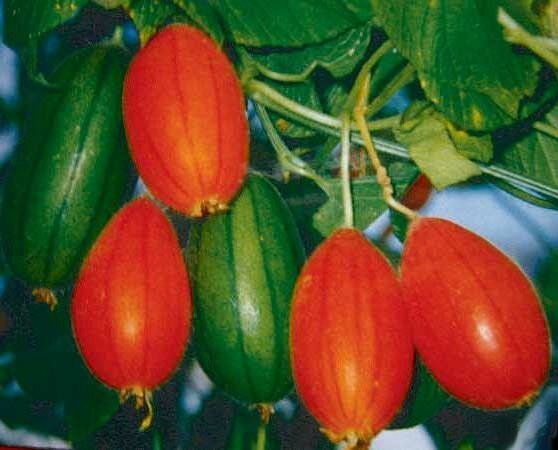

0
Doubtful Tladianta Another representative from Southeast Asia. The culture is propagated by seeds and tubers similar to potatoes. Tuberous propagation is the most acceptable and not time consuming. In one place without a transplant, Tladiant can grow up to 10 years. By the way, the dubious tladianta is the only frost-resistant species out of 20 existing grows on the territory of Russia.
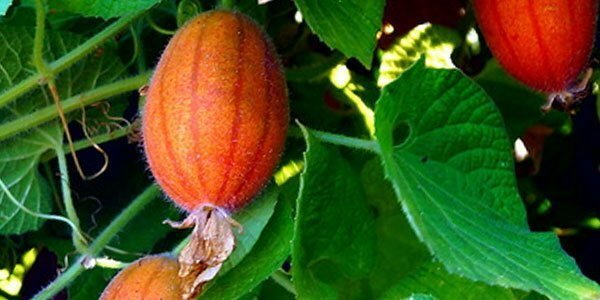

0
The culture needs constant moderate watering, does not tolerate waterlogging (tubers die). The fruits of the tladians are eaten. Green fruits are salted and canned like ordinary cucumbers or zucchini. Ripe red fruits have a sweet taste (they taste like kiwi and pineapple) and can be eaten fresh or made with jam, jam or candied fruit. An interesting fact from the life of a dubious tladiant. Her life is closely connected with her only pollinator - a tiny wild bee from the genus Ctenoplectra.
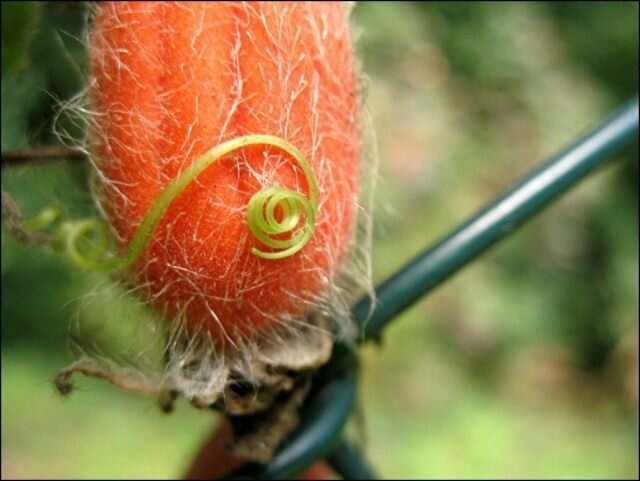

0
In the evening, this insect climbs into the opening bud of a male flower. After spending the night, the next morning the bee flies to the female flower and leaves the brought pollen. This bee never visits melons and, on the contrary, domestic bees, as well as bumblebees and wasps pollinating cucumbers, melons and pumpkins, never sit on dubious tladiana flowers. Well, where this bee is not found, then with a cotton swab, a cotton swab ...
CRAZY CUCUMBER THIS IS A LIANA WITH STICKS
Already at home, I learned that the plant is called common mad cucumber, or prickly fruit. Belongs to the pumpkin family. Distributed in Central and Asia Minor, in the Mediterranean, in the Caucasus and in the south of Russia and Ukraine.
This liana is an annual, very unpretentious, and therefore is often found in the wild. Its stems reach a length of 1.5 m. The leaves are large, up to 20 cm long and up to IS cm wide. The flowers are pretty pretty, yellowish, fragrant. In horticulture, prickly fruit is used for landscaping terraces, gazebos, arches, fences, walls, balconies.
Long-fruited cucumbers
Among the cucumbers there are real heroes up to 1.5 m long and weighing up to 5 kg.When growing them, one cannot do without a support in the form of a trellis, since the length of the lash reaches 4 meters. Some gardeners place them near the fence. Consider the features of these cucumbers.
Armenian cucumber
Differs in good seed germination, resistant to temperature changes. Its fruit has longitudinal grooves, slightly ribbed, covered with a light fluff and has a melon aroma, for which it was named Silver, or Serpentine melon. Can be up to 50 cm in length. It can be stored quite well and can be salted of any kind.


Armenian cucumber
Chinese cucumber
The length of the fruit reaches 80 cm, in most cases it has a smooth Asian shirt, salting it is contraindicated. It should be consumed on the same day that it was plucked, as the fruit dries quickly. In China, it is used in the preparation of traditional spicy vegetable salads.
He has a small seed germination, only up to 25%. It forms few side shoots, so it can be planted denser.
Trichozant serpentine
Homeland - subtropics and tropics of South and Southeast Asia, where he is very popular. Even the stems, leaves and tendrils of the plant are eaten there. Ripe yellow, orange fruits with red flesh are eaten raw, stewed and boiled.
Its fruit is a cross between a cucumber and a pumpkin, but more tender and sweet than a cucumber, reaches a length of up to 1 m and up to 10 cm in diameter, weight 1-5 kg.
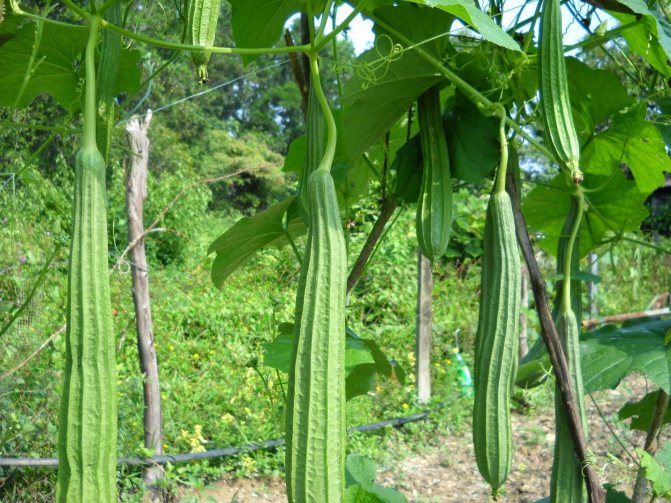

Trichozant serpentine
Interesting! To prevent the fruit from being bent, a stone is tied to the end of it.
The snow-white flowers of this Japanese cucumber, similar to snowflakes, are very beautiful.
Lagenaria
The homeland is the tropics of Africa, but it also grows in Vietnam, for which it received the name Vietnamese cucumber - a cross between zucchini, cucumber and pumpkin. Vine weaves reach 15 m and are used to make all kinds of wickerwork. Unripe fruits have a bitter spicy taste and are used for food.
From the hard peel of dried overripe fruits, they make smoking pipes, dishes, musical instruments. Depending on the shape of the fruit, lagenaria is distinguished serpentine, bottle-shaped, log-shaped. Interesting Lagenaria African Teapot with a long thin neck and roundness in the lower part, the length of the fruit reaches 1 m. Large beautiful flowers of the Lagenaria bloom after sunset. The plant cannot withstand even a slight frost and dies at sub-zero temperatures.
A friend of a pub
As I was convinced, the mad cucumber grows well in Central Russia. Agrotechnology is the same as that of courgettes and pumpkins.
Before planting, rub the creeper seeds on sandpaper to make it easier for the sprouts to break through the tough shell. And then soak them in a weak solution of potassium permanganate for a day and place them in a bowl with wet sawdust. Cover with a bag. Put the dish in the refrigerator for a month. Then move it to warm (at least 25). When the roots appear, plant the seeds in pots with a substrate of humus, leafy soil, peat and sand (2: 2: 1: 1). You can try to sow seeds and immediately into the ground, but only when stable heat is established.
Cucumber shirts
Types of salads - the best varieties for open ground
So the gardeners called the appearance of the skin, it is worth taking a closer look at it.
"German shirt" has longitudinal stripes, frequent tubercles and spines not only on the tubercles, but also between them, from which the cucumber even seems fluffy. The size of such a cucumber is no more than 12 cm.
"Dutch shirt" is covered with frequent tubercles with spines at their ends. Dutch cucumbers are larger than German cucumbers and often have bouquet ovaries characteristic of gherkins.
"Russian (Slavic, oriental) shirt" - with rather rare, randomly scattered tubercles, which are covered with black or brown spines.
Cucumbers without thorns, smooth, rather large have an "Asian shirt".
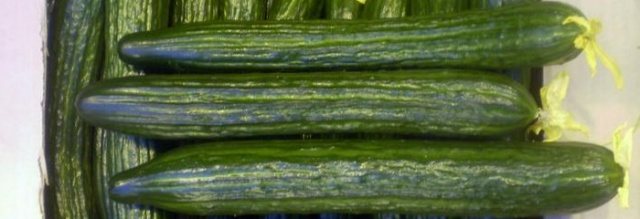

Cucumbers without thorns
If the fruits still have rare bumps, then we are talking about a "Korean-Japanese shirt".
Separately, it should be said about white-thorn and black-thorn cucumbers. White-thorn cucumbers are salad cucumbers, it would be a mistake to salt them, since the saline solution does not penetrate through the thick skin. Black thorns have a thin skin and feel great in pickles.
Transplanting a mad cucumber into the open ground
In late May - early June, plant the seedlings in open ground at intervals of 35-50 cm. Pour half a shovel of humus into each planting hole.
Liana grows both in the sun and in partial shade. If only there were no drafts. Soils for it are preferable weakly acidic sandy loam or light clay, well drained. Watering is needed moderate. Fertilization - twice a month with a solution of mullein or bird droppings (shovel in a bucket of water).
Flowers on the plant are formed from July to autumn frosts. The fruits ripen in late August - early September. But I cut them off earlier, leaving only a couple of testicles. Indeed, with uncontrolled "explosions" of mad cucumbers, their seeds scatter to the sides at a distance of up to 20 m! Then dig up the seedlings all over the garden!
How to grow mad cucumber
To take advantage of all the positive properties of mad cucumber, you need to know how to properly grow it on the land.
Preparing for landing
The seedling begins to be planted in the ground in the spring. The most favorable period is when the apple tree fades, since by this stage of spring the threat of frost has already passed.
The soil must be warm, light and permeable for the plant to take root. The air temperature should be above zero, since at low temperatures the bush will not grow.
You can create any lighting for a plant: a cucumber is unpretentious and will grow both in the shade and in the sun. It is better to plant it next to fences or a wall, since it tends to curl along a vertical surface.
Planting process of mad cucumber:
- The seeds must be left to soak in a solution of potassium permanganate for 1 day.
- Make holes 0.5 m apart.
- Place fertilizers in the holes.
- Place the prepared seeds in the hole in pairs.
Caring for him during cultivation
This plant is very unpretentious and grows in almost any conditions. However, if you want to grow the fruits of a mad cucumber, not only to decorate the fence in the country, you need to follow simple rules for caring for it.
Temperature regime
The roots of the cucumber do not withstand extreme cold, so its planting should be scheduled for mid-late May. The best temperature for a plant is 23–25 ° C in partial shade. High humidity leads to plant decay and death.
Watering
This vegetable does not require a lot of moisture, but it must be watered along with the rest of the plants on the site. Watering the plant needs moderate. In dry weather, the soil near the plants is moistened more often.
Top dressing
The seedlings need to be fed with mineral and organic fertilizers. To do this, use a mixture of humus or bird droppings. 1 shovel of the mixture is enough to prepare 1 bucket of fertilizer. Fertilizers are used once every 2 weeks.
BEFORE THE "EXPLOSION" OR AFTER?
I collect mad cucumber seeds with all the precautions. When the stalks of the testes turn yellow, I put on glasses to protect my eyes, take a cucumber and carefully place it inside a plastic bag. Then I sharply shake the fruit, it spews a jelly-like mass with seeds from itself into the bag. This mass, due to fermentation with the release of gas, causes increased pressure inside the shell of the fruit, leading to an "explosion".
After completing the operation, it remains only to select seeds from the bag in a strainer, rinse them under running water from the tap and dry them on a napkin.
The seeds can also be harvested after the natural explosion of the fruit. It is easier, but some of the seeds may fly away in an unknown direction.
White cucumbers
Work on the breeding of white cucumbers was carried out back in the mid-60s of the last century, to date, many varieties have been obtained.Their advantage in comparison with the usual ones is a sweeter taste and cold resistance, which allows them to bear fruit before the first frost. Otherwise, they are the same as their green counterparts.


White cucumbers
White cucumber varieties:
- US Scientist's Salt and Pepper is a rounded white cucumber with black specks resembling ground black pepper.
- Crystal Lemon is bred by Australian breeders. In shape resembling a white lemon, it seems to be filled with life-giving moisture.
- Dragon eggs have a rounded, flattened shape at the ends, snow-white flesh and a greenish jelly-like core with seeds.
- The angel is distinguished by longitudinal stripes of white and green.
HEALING PROPERTIES OF RUNNED CUCUMBER
Rabid cucumber is widely used in folk medicine to treat liver, kidney, colds, trophic ulcers, and neuralgia. Fruits, leaves, and shoots are also used. However, it must be remembered that mad cucumber is a poisonous plant. You cannot taste any of its parts! Even the juice from the stems and leaves of a vine, getting on the skin, can cause irritation, burns, and ulcers.
It is necessary to be treated with home-made preparations from mad cucumber under the supervision of a doctor, since an overdose of them is fraught with increased heart rate, dizziness, abdominal pain, and vomiting. Such treatment is contraindicated in case of exacerbation of diseases of the gastrointestinal tract, during pregnancy, breastfeeding and children under 18 years of age.
An interesting plant is a mad cucumber - Ecballium elaterium (L.) A. Rich, a representative of the Pumpkin family (Cucurbitae). Inside its ripe fruits, a pressure of up to 8 atmospheres is created; when overripe, they break off from the stalk and "shoot" seeds with incredible force, scattering them over a distance of several meters. Ripe fruits behave in the same way when a person or animals touches them, covering them with sticky mucus with seeds. Rabid cucumber is poisonous, but has long been used to prepare medicines for the treatment of edema and liver disease. Mad cucumber is not recognized by official medicine, therefore all recipes are folk.
Exotic varieties of cucumbers
On a note. All exotic types of cucumbers have unusual names, but they can be grown on a windowsill, loggia or balcony, like ordinary local crops, and even get a small harvest. They are also very decorative. It is only important not to allow the soil to dry out during cultivation.
Momordica Harantia
It has beautiful bright yellow flowers with a delicate aroma of jasmine, momordica is often used in landscape design to decorate gazebos. The fruits are 10-20 cm long, covered with protrusions of different sizes, like the skin of a crocodile, and have the shape of a spindle, pointed at both ends.
The green fruits of momordica are used as food like regular cucumbers. Momordica peel is a bit bitter, but this is redeemed by its beneficial properties: it cleanses blood vessels and improves visual acuity. Ripe momordica is a yellow cucumber with a beautiful pattern and dark ruby pulp, reminiscent of persimmon. The overripe fruit cracks into 3 parts and looks like a crocodile with red-brown seeds in its "mouth". With these seeds, Momordica is propagated by seedlings. It is enough to rinse them in a solution of potassium permanganate, they should not be soaked, otherwise they can rot. They are planted with an edge.
Young shoots and leaves of Momordica are also used for food, but it should be remembered that before the beginning of fruiting, the stems of Momordica sting like nettles.


Momordica Harantia
Kiwano
Originally from Africa. Its fruit has a rounded, slightly elongated shape with rare bumps on the skin, at first it is green with beautiful stains, and as it ripens, it is orange with a green sweet and sour jelly-like pulp, which is scooped out with a spoon. There is not enough daylight for the ripening of Kiwano in the northern regions, but breeders have bred the first Green Dragon variety specifically for our climate.
The pulp of the fruit is curative for cardiovascular diseases, promotes healing of wounds and bleeding, is used in cosmetics in the form of masks. Green Kiwano fruits can be salted or pickled, and jam can be made from ripe fruits.
The hard peel of ripe Kiwano fruits allows them to be stored at room temperature until almost spring.
Anguria
Its scientific name is translated as "watermelon cucumber".
Antillean Anguria was domesticated by the Indians. Anguria Syrian, or Syrian cucumber, has smaller fruits than Antillean.
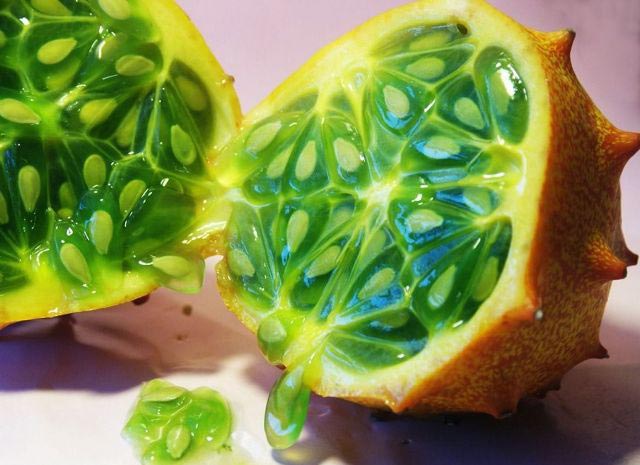

Anguria
The beautiful leaves of the anguria, similar to watermelon, and the green fruits on long thick stalks with numerous soft green thorns outwardly resemble the fruits of a mad cucumber. Unripe fruits are juicy and firm, like a regular cucumber, they can be eaten fresh, salted and pickled. As it ripens, the fruits turn orange or red and tasteless.
Melotria rough
These mini-watermelons with a marbled white-green color measuring only 1.5-2.5 cm are originally from equatorial Africa. In addition to edible, melotria has a decorative value - it has beautiful smooth cucumber leaves, yellow single female or male flowers collected in inflorescences. With the help of melotria, gardening of gazebos and rotundas is achieved in a short time. Melotria also has edible roots, which in taste and shape resemble an elongated radish or sweet potato; they are harvested after the end of picking cucumbers.
Melotria rough
The peel of the fruit of melotria is sour, for which it was nicknamed "sour gherkin".
Note! Its fruits and roots are contraindicated for gastritis and increased acidity of gastric juice.
Only one variety has been obtained for planting in the middle lane - Melotria Kolibri. For growing seedlings, seeds are not sprinkled, but covered with glass.
The same cultivation techniques are applicable to all exotic varieties of cucumbers as to the usual ones. Most often they are grown through seedlings. All of them are bee-pollinated, so they can be planted in open ground, but they grow well in greenhouses.
Squirting cucumber
It is known for its fruits that throw seeds over a distance of more than 6 meters. The peak of his popularity came in the 60s of the last century, when he grew up near the fences of many dachas and houses. Very decorative, its fragrant flowers attract bees. Its fruits are inedible, moreover, the whole plant is poisonous and, in some cases, if ingested uncontrollably, can be fatal. However, the dried herb and roots of the plant are medicinal and are used in folk medicine.
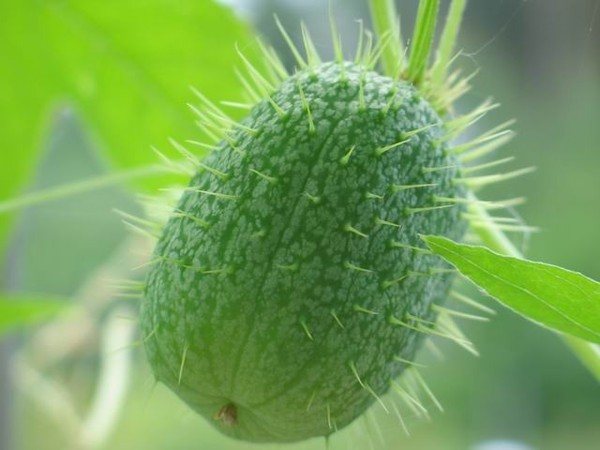

Squirting cucumber
Biological description
An annual, monoecious herb with a creeping stem, reaching a length of 70-150 cm. The stem is covered with rough hairs. Taproot, fleshy. Leaves are alternate, heart-shaped, crenate-toothed, up to 20 cm long, tomentose below, wrinkled, grayish-green in color.
The mad cucumber has regular pale yellow flowers: staminate ones are collected in lateral few-flowered brushes; pistillate - solitary, located in leaf axils on long pedicels. The berry-like oblong fruit is 5 to 10 cm long and covered with stiff bristles. The mucus that fills the fruit ferments and creates pressure as it ripens, which allows the cucumber to scatter the seeds with a strong stream of liquid. The plant blooms from July to September, the fruits ripen by October. Crazy cucumber grows in littered places mainly in the seaside zone.
Collection and procurement
For medicinal use, unripe are harvested fruit
plants. They are used fresh, processed into juice, or dried at a temperature of 45 degrees. Dry fruits are stored separately from other raw materials due to their toxicity.
Sometimes used for preparation plant roots and grass
.
Dried raw materials are stored in a closed container for one year.
Chemical composition
The chemical composition of the plant has not been completely studied; it is known that the fruits contain organic acids, proteins, alkaloids and vitamins. The active ingredients - elaterin and elatericin - have the main medicinal effect.
Botanical description
From top to bottom: General view of the plant. Sheet. Flower. Flower diagram (A - male, B - female). Fruit.
Stem prostrate or ascending, without antennae, 50-150 cm long, with short, more or less rough branches. The root is thickened, pivotal, slightly branched, whitish, fleshy.
Leaves are alternate, cordate-ovate or slightly lobed, crenate-toothed, 5-10 (up to 20) cm long, 4-8 (up to 15) cm wide, gray-tomentose below, wrinkled, rigidly rough, with thickened, prominent veins. Leaf petioles are fleshy, rolling, bristly-rough, 5-15 cm long.
Flowers are unisexual, monoecious, very rarely dioecious. Stamen flowers on long peduncles in axillary racemose inflorescences; flower receptacle short-bell-shaped; sepals, five, linear-lanceolate; corolla pale yellow, broadly campanulate or almost wheel-shaped, deeply five-part; five stamens, of which four are fused in pairs, one is free. Pistillate flowers are solitary, on peduncles usually emerging from the same leaf axils as the peduncles of staminate flowers, with three to five short ligulate staminodes; the perianth of pistillate flowers is similar to that of staminate flowers; inferior ovary, oblong, bristly, with three placentas; the column is short, with three bipartite stigmas. Blooms in July - September.
Fruits are gray-green or green, juicy, oblong or oblong-ovate, 4-6 cm long, 1.5-2.5 wide, spiny-bristly, obtuse at both ends, polyspermous. Seeds are dark brown, elongated, small, compressed, smooth, narrowly bordered, about 1 cm long. When the seeds ripen, the surrounding tissue turns into a mucous mass. In this case, a lot of pressure is formed in the fruit, as a result of which the fruit is separated from the stalk, and the seeds, along with mucus, are forcefully thrown out through the hole formed. The seed ejection process uses jet propulsion. A mad cucumber "shoots out" its seeds at a distance of more than 6 m. The weight of 1000 seeds is 13-22 g. Fruits ripen in August - September.
Beneficial features
Crazy cucumber has the following effect on the body:
- Diuretic.
- Laxative.
- Antihelminthic.
- Antineoplastic.
- Antibacterial and anti-inflammatory.
- Local irritant.
- Application
In folk medicine, medicines made from mad cucumber are used:
- Tincture
alcohol fruit - it is used as a rubbing for rheumatism and neuralgia. It has been proven to be effective in treating sciatica - inflammation of the sciatic nerve. - Fresh the juice
fruits, leaves and roots - for the treatment of hemorrhoids, headaches, sinusitis; as a diuretic for edema of unknown origin. Also, the juice is used for constipation and for the expulsion of worms. It is used externally to treat vitiligo, lichen and tumors. - Decoction
fruits and roots - used in the complex treatment of malignant neoplasms. Outwardly, the broth is applied in the form of compresses for gout, non-healing wounds. - Powder
dry fruits - as a powder for skin diseases.
The fruit extract was successfully applied in 1972 by the Bulgarian phytotherapist Stoyanov for the treatment of viral hepatitis (jaundice).
Growing seedlings of cucumbers from seeds
Seeds of cucumber for growing seedlings are sown 25-40 days before planting. The earlier the seedlings are planted, the greater the age. Before sowing, to activate enzymatic activity, the calibrated and pickled seeds are soaked for 12-16 hours at a temperature of 20 ℃ in a fertilizer solution (for 1 liter of water, 10 g of superphosphate and potassium nitrate, 0.2 g of manganese, zinc and copper sulfate salts each).To accelerate the emergence of seedlings, the seeds are germinated. They are sown directly in 10 × 10 cm pots to a depth of 1–1.5 cm.
Cultivation of cucumber seedlings is carried out with a moderate water supply and a relative humidity of 70–80%. The optimum soil temperature during the period from sowing to germination is 26-28 ℃, in the rest of the period - 23-24 ℃. On sunny days, the air temperature should be 24-26 ℃, on cloudy days - 20-22 ℃, at night - 18-20 ℃. When growing seedlings for unheated greenhouses, it is advisable to lower the night temperature by 1–2 ℃ and harden the seedlings. To do this, the temperature is reduced within 4 days after their appearance to 20–22 ℃ during the day and to 15–16 ℃ at night.
To prevent diseases with olive spot, anthracnose, bacteriosis, seedlings are sprayed 1-2 times with 1% Bordeaux liquid or 0.3% copper oxychloride.
Only complete, healthy plants are planted. Seedlings of pollinating varieties (Phoenix and Nezhinsky can be used as pollinators) 5–7 days older than the seedlings of the main hybrid. This is necessary in order to guarantee the appearance of the male flowers at the time of the female bloom.
Here you can see a photo of growing cucumbers from seeds:
Harm and contraindications
The plant is poisonous and requires strict adherence to the dosage. Ingestion 0.6 g. fresh juice can lead to fatal poisoning. When applied externally, allergic manifestations are possible in the form of skin irritation and the appearance of bubbles, therefore, fresh juice must be diluted with water. The use of mad cucumber is contraindicated for people suffering from serious diseases of the heart, stomach and intestines; pregnant women and children. In children's practice, the use of homeopathic preparations of mad cucumber is allowed.
Photo of mad cucumber
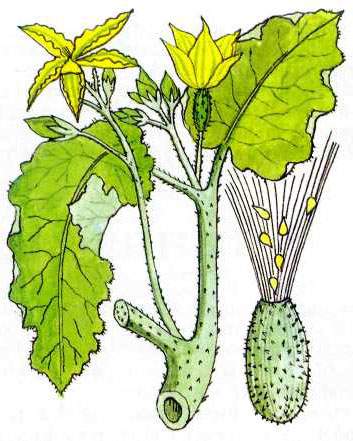

Growing
The plant is unpretentious, rarely affected by diseases and pests, so it is easy to grow it in a personal plot. For reproduction, seeds are used, sowing them in the same way as the seeds of squash or pumpkin.
You can grow seedlings that are planted in open ground after the threat of frost has disappeared. Plants are placed at a distance of 50 cm from each other; it is good if there is a fence, pillars or other base nearby that allows cucumbers to weave.
The number of fruits will increase, provided there is good watering and lighting, it is recommended to fertilize young plants.
Wild cucumber is an unusual crop of the pumpkin family. It gained popularity due to its ability to throw seeds. And also for unpretentiousness in care and resistance to disease.
Used by gardeners for decorative purposes and in folk medicine. This is a poisonous plant, so you need to be extremely careful with it.
Pollination method
Common cucumbers are dioecious plants with male and female flowers. In order for the ovary to form, bees, bumblebees and other insects transfer pollen from flower to flower. Such cucumbers are bee-pollinated.
Self-pollinated cucumbers are characterized by the presence of stamens and a pistil on each flower, so pollination takes place without much hassle. They can be grown both outdoors and in a greenhouse.
Parthenocarpic cucumbers were bred specifically for greenhouses, the greenhouse icon is drawn on a bag with such seeds. If planted outdoors and bees mistakenly pollinate them, cucumbers can grow hooked or pear-shaped.
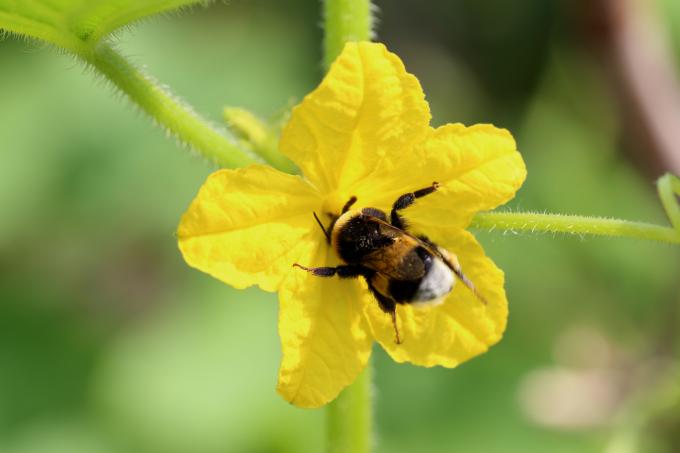

Pollination of cucumber flowers
Note! Most parthenocarpic varieties are hybrids.
F1 stands for open field hybrid seed pouches. These seeds are obtained by crossing different varieties. The number "1" indicates that these are hybrids in the first generation and that no cucumber seed is formed in them, that is, it is impossible to get seeds from them for planting.
However, hybrids also have undeniable advantages: they are more resistant to diseases and temperature changes, and are more productive.
A prominent representative of parthenocarpic cucumbers is the famous Baku cucumber, which resembles a patron, no larger than the index finger. It has a slightly astringent taste. You can meet him in stores at any time of the year.
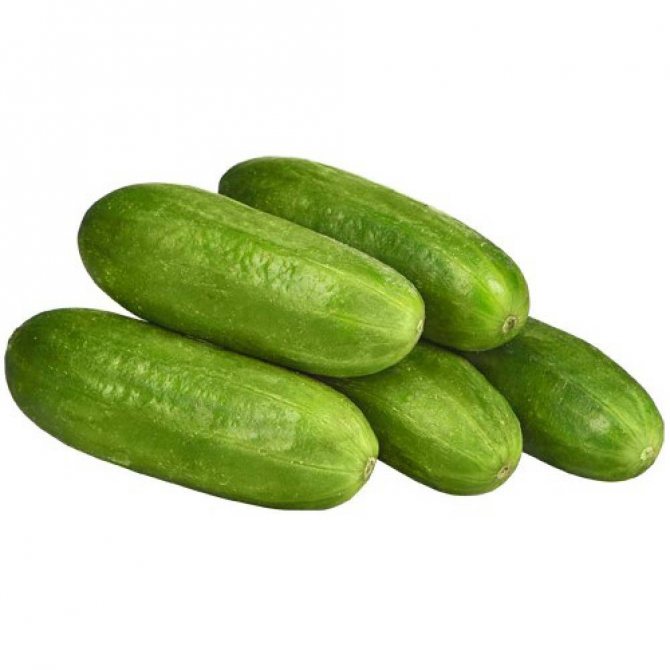

Baku cucumbers
Variety characteristic
The culture got its name from its interesting breeding method. It is also called echinocystis or prickly fruit. Crazy Cucumber is an annual herb. It is the only representative of this species. Momordica is the most famous variety. Originally from North America, in the XIX century was brought to Europe. Now distributed in the Azores, in the Mediterranean, in the south of Russia and Ukraine, in Asia Minor and Central.
In the wild, it occurs near roads, in garbage places. Can be seen as a weed near the sea.
Description of the bush
The culture looks like a vine. It develops rapidly, stretches upward along the support. The length of the shoots is up to 6 m, in good conditions it can reach 10 m. The stem of the plant is without antennae. It spreads along the ground, has small villi on its surface. The root is white, thick, fleshy.
Description of leaves: arrangement on petioles alternate, heart-shaped or triangular in shape. They have denticles along the edges. The top is green, the bottom is wrinkled, grayish felt. The size is 5-10 cm, it can reach 20 cm. The petioles are fleshy, their length is 5-15 cm.
Crazy Cucumber flowers are regular, pale yellow. They are unisexual, monoecious, rarely dioecious. The flower has the shape of a corolla, five-part. There are five stamens, four of which are accrete, the fifth is placed separately. Pistil of three carpels with a lower ovary. The aroma is pleasant, reminiscent of the smell of gardenia. Therefore, the plant attracts insects, especially bees. This significantly increases the yield of horticultural and horticultural crops. Flowering occurs in July-September.
Description of the fetus
After flowering, juicy fruits are formed. The color is green or gray-green, the shape is ovoid. Length from 3 to 6 cm, width - 1.5-2.5 cm. Seeds are dark brown, their surface is smooth, about 4 mm long. They have spiny bristles. The skin is thin. Maturation takes place in August. Then the fruits turn yellow. If you touch them, seeds are shot. This is due to the high pressure that forms inside (up to 6 atmospheres). Because of this, the plant received such a name. Crazy Cucumber seeds spread up to 6 m, splattering everything around with mucus. This is how culture multiplies.
If the ripe fruit is not touched, it falls off the dried stalk. A hole is formed through which the seeds come out.
The fruits of mad cucumber can only be eaten by young people at the age of 10. In the more mature, they are very bitter. Before use, they are soaked in salt water for 10-12 hours. The procedure can be repeated until the bitterness is gone. The skin must be removed. The pulp is used for making salads or stewed.
Also, the Mad Cucumber plant is used in the medical practice of traditional medicine. After all, it has beneficial properties due to its valuable composition. Scientists are studying them to this day. These wild fruits are known to contain:
- alkaloids;
- glycosides (elaterins, elatericins A and B);
- sterols;
- nitrogen-containing compounds;
- fatty and organic acids;
- proteins.
The presence of carotenoids, triterpenoids, vitamins C and B1 has been proven.
Our ancestors used not only green fruits for medicinal purposes, but also stems with juice. Used for diseases such as worms, dropsy, hepatitis and joint pain. It also has antineoplastic, diuretic, decongestant, absorbent and bactericidal properties. Fresh plant juice is useful for abscesses, fistulas and hemorrhoids. Gloves should be worn when preparing it to avoid burns.
It is necessary to use medications prepared on the basis of Mad Cucumber under the supervision of a doctor and monitor your well-being.Do not take them if pregnant or breastfeeding. Overdose threatens with nausea, dizziness, vomiting, abdominal pain, frequent pulse.
Description and chemical composition of the plant
The rabid, or wild, cucumber is a member of the Pumpkin family.
Did you know? This plant got its name due to the unique process of ejection of seeds: a ripe fruit, especially if it is picked, shoots seeds into the air.
Both an ordinary cucumber and a rabid one practically do not differ in appearance. The length of the stem is 30–85 cm, the leaves are covered with small thorns, triangular in shape, but most often heart-shaped. The upper part of the leaf is smooth, green in color, the lower part is faded, wrinkled, with small hairs.
The flower is pale yellow, unisexual, has 5 stamens (4 paired and 1 free), a five-part calyx and a five-part corolla. Pistillate flowers 1.5 cm in size are placed in the leaf axils on pedicels. Blooms in July and September. The fruits begin to form in August. The fruit is berry-like, green in color, elliptical, covered with small spines, located on a vertical stalk. Its length is 3–8 cm.
The mad cucumber multiplies in a peculiar way: in ripe fruits, strong pressure arises, they break off from the stalk, while the seeds are shot out of the fruit and scatter to the sides. The spread of seeds of this vegetable reaches 12 m around the main bush.
Seeds of wild cucumber are dark brown in color, small, smooth, slightly compressed. The seed length is 4 mm. During the ripening period, the seeds are in a closed mucous mass.
The chemical composition of the vegetable has not been fully investigated, only some of the components of this plant are known.
The stem and root of the cucumber contains:
- carotenoids;
- triterpenoids;
- alkaloids;
- steroids;
- vitamins of group C and B;
- organic and fatty acids.
The fruit contains:
- Elasericin A and B;
- vitamins of group A, B and C;
- alkaloids.
The distribution area of mad cucumber is the southern territories. It grows in the Azores, in the Mediterranean and Asia Minor, in southern Russia, in the Crimea, as well as in the Caucasus and Central Asia. Important! Crazy Cucumber is a poisonous plant that can even kill a person.
Beneficial features
This plant, despite the poisonous substances in its composition, also has useful properties.
- Its fruits have such a positive effect on humans:
- laxative and diuretic;
- antineoplastic;
- anthelmintic;
- antibacterial.
It should not be forgotten that the plant is very poisonous. By ingesting just 0.6 g of wild cucumber juice, you can die.
- The negative effects of a mad cucumber include the occurrence of such ailments:
- pancreatitis;
- diseases associated with the heart;
- stomach diseases;
- stool problems.
Important! The use of mad cucumbers during pregnancy is strictly prohibited.
Growing
Momordica loves sunny places, but can grow in partial shade. Does not accept drafts. They are planted near the supports along which the vine will curl. It should be borne in mind that it has the ability to spread to other plants that are located nearby.
The most suitable soil for growing crops should have the following properties:
- water permeability;
- ease;
- neutral or slightly acidic.
Loamy or sandy soils meet these criteria. If the composition of the land is not suitable for cultivation, it can be improved. To neutralize the overestimated acidity, liming is carried out.
Planting in open ground
Momordica is planted both by sowing directly into open ground, and by seedling. You can buy seeds at the store or prepare yourself. For this, the fruit is placed in a bag and shaken. The content remains in it. The seeds are washed. Sometimes they are simply harvested when the plant shoots. But then most of them will fly away in an unknown direction.
Wild cucumber seeds can be planted even in autumn.They tolerate winters well and germinate well due to cold stratification. They must first be soaked. But it is better to plant after the end of the frost. It's around the beginning of May.
The planting site is moistened. The distance between the bushes should be 30-50 cm.
Growing seedlings
The preparation of the seed of the Crazy Cucumber plant should be started in April from scarification. For this, the tip of each seed is rubbed with sandpaper, since their shell is very hard. Then it is poured with a warm solution of potassium permanganate. Leave for several days. To germinate seeds, they are placed in a box with wet sawdust or on a bandage moistened with water, gauze. The room temperature should be at 25 ° C.
After the appearance of small roots, the seeds are planted in cups, which are filled with soil mixture. For its preparation, take in equal proportions:
- leafy ground;
- peat;
- humus;
- river sand.
2 seeds are placed in each glass in order to remove a weaker sprout later. The vessels are left at home or placed in a greenhouse. The main thing is to keep it warm.
Seedlings are planted at the end of May. Water abundantly.
Pollination process
The formula for the pollination process is simple. The pollen must get into the eggs, which are located in the ovules. After that, little time passes before the ovaries begin to form. The parthenocarpic species can form ovaries without pollination.
The pollen is ideal for pollination only before lunchtime. After this period, she begins to lose her vitality. If the color of the female inflorescence has a rich color, it means that it is completely ready for pollination. If the process has not occurred, then after a few days the color becomes paler.
Care
Growing Crazy Cucumber is easy. On their plots, it is planted for decorative purposes. They are used to decorate balconies, house walls, gazebos, and hedges. In one or two months it grows, greening the desired surface. A wild plant adapts well to different environmental conditions.
It can be planted by itself, since it shoots seeds at long distances. Therefore, it does not always grow in the desired places. At a young age, the sprouts are easy to pull out and remove from the site. Also, during the winter, the roots disappear, so you should not be afraid of a strong spread of culture.
Watering
In addition to the sun, moisture is an important factor for the growth of prickly fruit. With normal natural moisture does not require additional watering. But in dry weather, it should be produced in moderation. You can water together with other crops.
Garter
In order to provide the culture with the necessary lighting, it is equipped with vertical trellises. Then the plant will not fall or break. If it is used to shade gazebos or other buildings, you do not need to tie it up. After all, he will cling to structures.
Top dressing
Although the Common Crazy Cucumber is not whimsical to care for, fertilizers are applied for a beautiful appearance and rapid development. If a seedling growing method is chosen, then for the first time feeding is done when it is planted in a permanent place. This is done at the end of May at the beginning of July. In each planting hole, half a shovel of humus is given.
Possible cultivation of the plant at home. It can be a window sill, a loggia or a glazed balcony. But then mineral fertilizers are applied, which are bought in specialized stores.
Crazy cucumber is a plant in the cucurbitaceae family, which is a climbing herbaceous tropical vine. It blooms with yellow fragrant flowers in a smell reminiscent of the smell of gardenia. After flowering, fruits are formed on the stems - round, slightly elongated orange-red. At this time, the plant is very attractive.
As they ripen, the fruits begin to crack and throw seeds away from themselves (sometimes up to several meters).Therefore, this plant was given a name - squirting cucumber.
The most popular variety of such cucumber is Momordica, translated from Latin this cucumber also “bites”. The fact is that when a mad cucumber grows, it burns like nettles. But when the fruit appears, all the pungency disappears.
Blooms: July - August, ripens: August - September.
Crazy Cucumber Care
Watering
It is not necessary to water the mad cucumber too much. A high moisture level should only be maintained in hot weather, sultry weather, or during a summer drought. The rest of the time, precipitation will provide the flow of liquid. It is advisable to water the growing plant from a watering can with warm water.
Top dressing
Crazy cucumber will grow without feeding, but you can get a dense green cover only with the help of fertilizers. They are fed 1 time every 2 weeks, mineral and organic dressings are used in turn. The ground should be wet at this time.
Of the mineral species, preference is given to fertilizers with a high nitrogen content. Alternatively, a solution of chicken manure (1 liter per 20 liters of warm, settled water) or mullein infusion (1 liter per 10 liters of settled water) is suitable.
Formation
The plant is formed with the bindings. When it grows to 1 m, the top is attached to some kind of support. So, the side pieces will begin to grow along the wall. If the mad cucumber is not formed in any way, its stem may break due to strong winds or simply during the growth process.
When and where to plant Mad Cucumber?
To decorate the walls of a house, a gazebo or a fence with weaving stems, a mad cucumber is planted on the garden plot. Besides the decorative qualities of Momordica possesses medicinal and healing qualities
, since her juice is poisonous. In folk medicine, cucumber is popular, only it should be handled very carefully.
This plant is easily propagated by seeds that germinate quite easily (like pumpkin or squash). Therefore, there is no need to pay any special attention to it.
Female flowering type
Please note that the female-type cucumber flowers are characterized by an ovary, or rather a small cucumber. In this they differ from the male type even before the onset of the flowering period. Parthenocarpic form a green ovary, without signs of pollination. It's safe to say that this type of bloom doesn't need the help of bees or other pollinated insects.
In order for bee-pollinated cucumbers to form ovaries and form a fruit, pollination with peasant-type pollen must be performed. There are the following points of flower formation:
- long-fruited hybrids are characterized by the fact that no more than 2 female-type flowers can form in one node;
- bunch cucumbers can form about 10 ladies' flowers in 1 node.
Causes of developmental disorders
Quite often, you can observe a situation when ladies' flowers develop longer than male ones. There are several reasons for this.
- These are the characteristics of the variety. Most of the varieties of cucumbers initially form a male flower, located on the main stem, and only then on the lateral shoots, a female species. This threatens that fertilization will be delayed indefinitely and the harvest will have to be harvested much later.
- The reason lies in the seed quality. Young seeds always form a maiden type first and only then a masculine one. If the seeds are characterized by an age of about 2 years, then the formation of flowering of both sexes occurs simultaneously. This allows you to speed up the process of fetal formation.
Application, treatment, useful properties
Preparations made from mad cucumber have a strong diuretic and laxative, antitumor, antibacterial properties.
A decoction from this plant used for diarrhea
, inflammatory kidney disease, hemorrhoids, inflammation of the nasal mucosa.
Externally applied with trophic ulcers
, with sinusitis, treatment of rheumatism, neuralgia, skin fungus.
Ecballium elaterium
Fruit tincture
You should collect the young fruits of a mad cucumber, rinse together with the skin (do not cut it off), cut into small pieces, fill a three-liter jar with them loosely. Pour everything with half a liter of vodka or alcohol and put the jar in a dark place for two weeks. Strain the finished medicine.
Take a tincture of this plant three times a day, one teaspoon, on an empty stomach. The treatment should be carried out for no more than three days. Thus, colds, psoriasis, rheumatism (externally) can be treated. The tincture works well to strengthen the immune system.
Decoction
Seeds are used for decoction. Put about 25 g of seeds in a saucepan, pour 200 ml of boiling water, simmer over low heat for about 10 minutes. Then wrap the pan for one hour. Strain the finished broth and take half a glass - three times a day. The broth helps with hemorrhoids and is used as a diuretic.
Meaning and application
It is prescribed internally for edema, malaria, jaundice of newborns, inflammatory diseases of the liver and kidneys, amenorrhea, hemorrhoids, malignant neoplasms of the uterus, diarrhea, gout, rheumatism, sciatica, neuralgia, with colic in the intestines, externally with fungal skin lesions, abscesses, inflammation of the nasal mucosa and sinusitis.
Decoction of fruits is used to treat rheumatism, abscesses, diarrhea, inflammatory kidney disease, colic in the intestines, hemorrhoids, inflammation of the nasal mucosa.
In folk medicine and homeopathy, the fruits are used as a strong laxative, for dropsy and other congestion, jaundice of newborns, intermittent fever, rheumatism, sciatica, neuralgia, gout, amenorrhea, as well as an antihelminthic and diuretic.
Medical contraindications
The plant is poisonous, therefore, treatment is carried out only on the recommendation and under the supervision of a doctor. In large doses, mad cucumber preparations cause nausea, vomiting, abdominal pain, colic, and rapid pulse.
Some recipes
For external use
For indoor use
- It should not be forgotten that mad cucumber juice is poisonous, even small doses can cause vomiting, diarrhea, drowsiness, and weakness. Decoctions from this plant are drunk with jaundice, malaria and worms.
- Freshly squeezed juice can be used for sore throat, diphtheria, otitis media, migraine, runny nose.
- For sore throat, the juice of the plant is mixed with honey and olive oil, the resulting product is used to lubricate the throat.
Contraindications
Crazy cucumber is a very poisonous plant and preparations based on it should be taken very carefully. Need to carefully monitor your well-being during treatment
... In no case should these drugs be taken during pregnancy and lactation.
When juicing this plant at home work with rubber gloves
... As if the juice gets on the skin, burns, blisters or ulcers may form.
preparations from mad cucumber should be taken only strictly under the supervision of a doctor.
Planting scheme for cucumbers in the greenhouse (with video)
In March-April, the planting of cucumbers in the greenhouse is carried out according to the scheme: 90–100 × 25–30 or 120 × 25 cm, that is, 3.3–4.4 plants per 1 m². The feeding area is determined by the growing period and varietal characteristics. The earlier the seedlings are planted, the fewer plants are placed per 1 m². The more the plants branch (F1 Souvenir, F1 Galit, F1 Ksana, F1 Slobozhansky, F1 Buyan, F1 Matryoshka, F1 Maryina Roshcha, F1 Chistye Prudy, etc.), the fewer plants are planted per 1 m².
The planting density increases in plants with moderate or limited branching (F1 Ant, F1 Grasshopper, F1 Kozyrnaya karta, etc.). When planting cucumbers in a greenhouse, only the pot is covered with soil, without deepening the stem. The root collar is not covered with earth, thereby reducing the possibility of plant disease with root rot. In the case of planting overgrown seedlings, it is buried to the hypocotal knee.For good survival of seedlings, especially overgrown ones, it is necessary to create a high air humidity in the greenhouse, close to 100%. There should be fog in the greenhouse, which is achieved by refreshing irrigation.
If, when planting overgrown seedlings, especially in cold soil, the growth of the assimilation surface is delayed and a large number of ovaries are formed, they are immediately cut off. The creation of conditions for the rapid growth of the assimilation surface is of great importance for obtaining a high yield of zelents.
Novice vegetable growers, wanting to get the first cucumber, often violate this rule, which greatly inhibits the subsequent growth and productivity of plants. The fact is that overgrown seedlings, caught in unfavorable conditions, tend to throw all their strength into the production of offspring to the detriment of the harmonious growth of leaves. 2-3 days after planting, the plants must be tied to a trellis to a height of 1.8-2 m. To improve the use of light, the plants are tied through one to the left and right wires.
Watch the video of planting cucumbers in the greenhouse to better understand the process technology:
Cooking applications
Momordica fruit can be eaten and tastes like persimmons. For consumption, you should take young ten-day (still green) fruits. If you take more mature ones, then you can't eat them.
as they are very bitter. Such fruits can be soaked in salted water for 12 hours. If, after soaking, they still taste bitter, you need to fill it with salt water again and wait a little longer.
After the bitterness leaves, you need to remove the skin, and the pulp can be used for stewing or preparing salads
... In addition, the fruits can be salted, pickled - just like ordinary cucumbers.
Besides the fruits of this plant, tubers, leaves and fresh young stems are used for food
... They can be used to make a light vegetable soup or add to salads.
The main characteristics of the plant
Outwardly, the culture looks like a tropical climbing liana. Her flowers are yellow. By their smell, they can be confused with gardenias, when flowering ends, round and elongated fruits appear - this is a mad cucumber. The plant burns during growth by analogy with nettle, but when the fruits appear, the characteristic pungency disappears. The culture begins to bloom in the middle of summer, and ripens closer to September.
A distinctive feature is that the seed of a plant has the property of scattering up to 20 meters around when ripe, thus the plant multiplies.
The culture is annual. It first appeared in the northern part of America, but now its distribution area is as follows:
- Central and Asia Minor;
- Ukraine and southern part of Russia;
- Azores;
- Mediterranean.
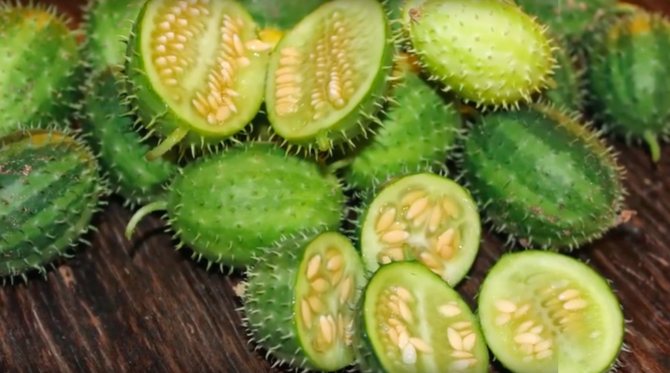

Under natural conditions, it can grow near the sea, as well as near roads. There are several varieties of plants, but there is only one type - common mad cucumber. It is also popularly called wild.
With regard to external features, the length of vine shoots can reach 6-10 meters. The root is thick and fleshy white. The leaves are triangular or heart-shaped, with denticles at the edges. They are green above, and gray-felt below. The flowers are pale yellow, some are unisexual, mostly monoecious, in the form of a corolla. They have 5 stamens, 4 of them are spliced, and the fifth stamen is located separately, the pistil consists of 3 carpels.
Characteristics of Big Beef tomatoes
The fruits are juicy when ripe, they are ovoid and can be green or gray-green. The seeds are smooth and dark brown in color.
Fruits can be eaten only at 10 days of age, if they are ripe, they will taste bitter. Before eating, they must be soaked for 10 hours in salted water. The procedure is repeated as necessary until the bitterness is completely gone.The skin is also removed, salads and other dishes are prepared from the pulp of the fruit.
Description
The plant belongs to the pumpkin family. Loves sandy soils, often found on the coast. As a garden crop, it is not grown, it is considered a malicious weed. The name of the weed was given by the spread of seeds.
Crazy cucumber burns like nettles until the fruit ripens
When the fruit ripens, a pressure of 6 atmospheres is created inside, the cucumber breaks off from the shoot, and the seeds are shot at a distance of 6-12 m around. This is how the seed spreads and the plant reproduces.
Botanical Description:
- thermophilic annual;
- creeping stem 50-120 cm long with antennae;
- leaves are hard, pubescent, gray on the inside;
- flowers are yellow;
- flowering time - July - September;
- fruits are oblong, 4-7 cm long, covered with bristles;
- ripen in August - September.
After ripening, the cucumber turns brown, shoots out elongated seeds in the mucous mass. The length of the seeds is 4 mm, similar to the seeds of an ordinary cucumber.
There is an annual cultivar called Momordica. It is used as a climbing ornamental plant to decorate the walls of a house, gazebo or other buildings.
Where does the red cucumber grow
As I already mentioned, Southeast Asia, Northeast China, and the Philippines are the homeland of the Tladians. But we also, in Russia, have places where this vegetable grows wild: in the Far East. On the Internet, I met a photo, the author of which asks: they walked and met such a miracle on the shore, what kind of plant it was. The author lives in the Primorsky Territory. Photo taken at the end of October:
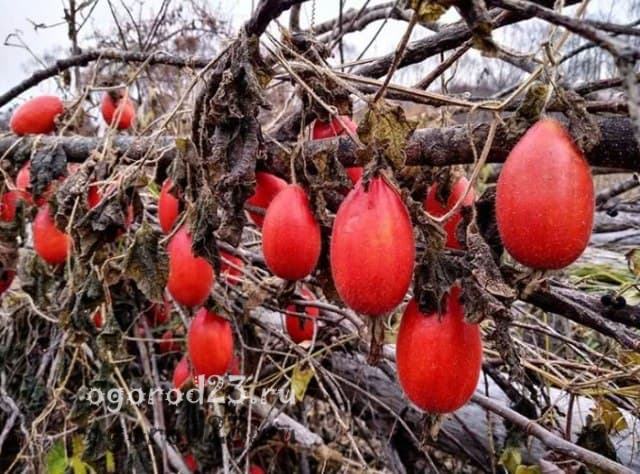

Tladiant in vivo
Prickly carp, or echinocystis
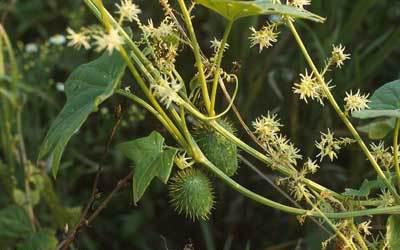

Unknowingly, many people call echinocystis a rabid cucumber, or, in a popular way, prickly fruit, bubble worm, shooting ivy. Indeed, these two plants are similar in appearance, especially in fruits. Echinocystis came to us from North America. Now it can be found in Europe and Asia, including Russia, and in the Mediterranean. The spread of rabid cucumber and echinocystis is made so widespread by their ability to shoot seeds.
There are many differences between these two plants. So, echinocystis flowers smell good and attract bees. Vines have antennae, with the help of which they crawl up the support. The leaves are smoother than mad cucumber. Flowers do not look like pumpkin flowers and are panicles. The seeds are large, reaching one and a half centimeters. Echinocystis fruits are edible. They contain many vitamins and mineral salts. Only people use this plant not for food, but to create a fragrant and beautiful hedge, decorate gazebos and arches with it. The medicinal properties of echinocystis have not yet been studied.
Description and distinguishing features
This plant is a large herbaceous perennial with a fleshy, thick root, small rough stems with tendrils, with large lobed, rigidly drooping leaves. On the underside, the leaves are grayish tomentose. Stem length 50-150 cm, stem lying.
The flowers are bright yellow. They are either arranged in a group or in single order. This species of the pumpkin family blooms from July to September.
The name mad cucumber also did not appear out of nowhere. When the fruits ripen, a hydrostatic pressure of almost 6 atmospheres appears in them. When someone touches a cucumber that is already ripe, a small "explosion" occurs - that one "shoots".
Seeds in sticky mucus "shoot out" in a strong stream from the hole that occurs when the cucumber breaks off the stalk. The seeds fly off at a distance exceeding 12 meters. Thus, they spread over a large area.
Possible contraindications
It must be remembered that the wild cucumber itself is very poisonous. Therefore, all funds based on it must be taken with extreme caution. If misused they can cause side effects such as:
- drowsiness;
- diarrhea;
- vomiting;
- general weakness.
During treatment, you must definitely monitor your condition. It is strictly forbidden to take the remedy during pregnancy or breastfeeding.
Always wear rubber gloves when juicing. If it gets on your skin, it can cause sores, blisters, or burns. All plant-based products should be taken only under the strict supervision of a physician.
Some recipes for external use
- Lichen
Grind the dried parts of the plant into powder and sprinkle the sore spot with it.
- Fungus
Prepare a foot bath. Take 200 grams of fresh plant, pour 3 liters of boiling water and insist. You can add a spoonful of honey to the infusion. With such an infusion for the prevention of fungal diseases, they wipe the shoes from the inside. It is believed that the infusion of mad cucumber relieves not only of the fungus on the skin, but also on the walls.
- Gout
Squeeze the juice of a cucumber, mix with vinegar. Moisten a cloth in the solution and apply to a sore spot.
- Trophic ulcers
Crazy Cucumber has been successfully used in the treatment of hard-to-heal wounds. To do this, you need to prepare a decoction at the rate of: a tablespoon of dried and crushed raw materials in a glass of boiling water. Heat in a water bath for 15-20 minutes. Strain immediately and add water to make one glass of liquid again. For treatment, take a teaspoon of flour and a tablespoon of broth, prepare a cake from it and apply to the ulcer.
- Hemorrhoids
Boil the cucumber in sesame oil. Lubricate hemorrhoids with the resulting agent.
Varieties of cucumbers "gherkins" for open ground
Gherkins (small-fruited cucumbers, removed until fully ripe when they reach a size of no more than 4-8 cm) are excellent for canning and pickling.
Among the most successful varieties are:
- Parisian gherkin (2006),
- Merry company (2003),
- Advance payment (2008),
- Gerda (2007).
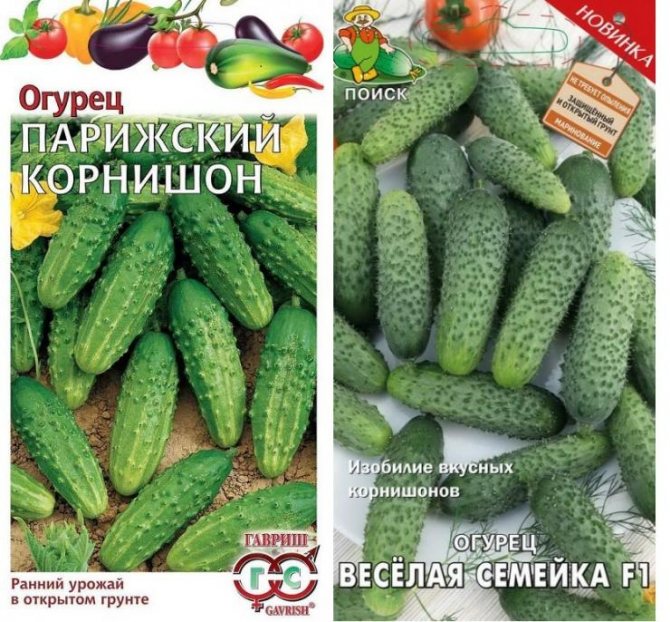

Photo: Parisian gherkin and Merry family
Parisian gherkin
It is recognized as almost the best variety from which gherkins are harvested. Early maturing bee-pollinated variety. Excellent for salads, pickling, canned products. The plant is of an indeterminate type, the bush is medium-sized and weakly branching. The flowers are mostly female. Greenies are short, fusiform, green in color with stripes along the length of the fruit. Large tubercles and black pubescence of medium density are noticeable on the surface. On good soil, the mass can reach 78 g. Gherkins have excellent taste, they need to be harvested every day and they are suitable both for fresh consumption and for canning or pickling.
Prepaid expense
Gherkins from Advance also need to be harvested daily. This is parthenocarpic for salad and canning purposes, gives the first cucumbers 41 days after germination. The branching of the plant is average, the type of flowering is predominantly female, and in one node there can be up to 3 or more flowers. Zelentsy are short, cylindrical and dark green in color. The stripes are rather short, there are tubercles, they are medium in size. Dense, white pubescence is present. Fruit weight on nutritious soil sometimes exceeds 115 g. The taste is simply wonderful, the yield is up to 12.2 kg per 1 m². Of the advantages of the variety, it is possible to note resistance to cladosporia and root rot.
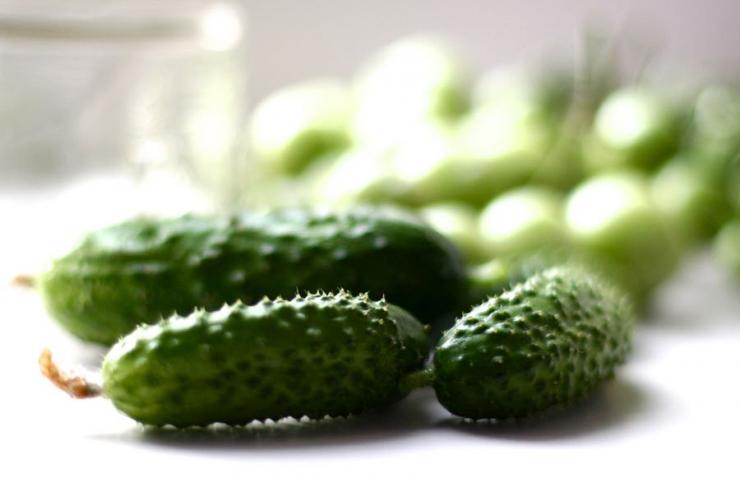

Growing and caring for cucumbers in a greenhouse: maintaining air humidity
One of the prerequisites for growing cucumbers in film greenhouses is the maintenance of the required air humidity - at least 85–95%. In areas with low relative humidity, this is achieved by a combination of forced ventilation with air humidification or refreshing irrigation, which is also an effective means of combating overheating - the main reason for the decline in the productivity of cucumbers in the southern regions.
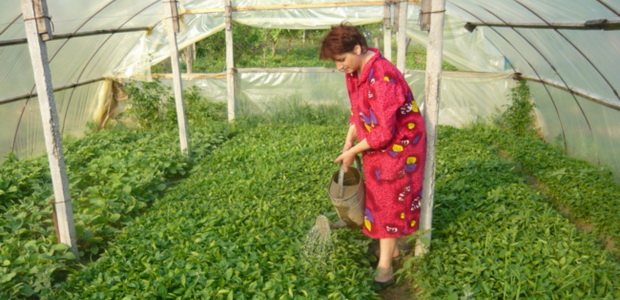

When growing and caring for cucumbers in order to enhance the growth of stems, leaves and greens, humidification of the air in the greenhouse is widely used with watering at a rate of 1.5–2 l / m². It is carried out between main waterings, spraying paths, soil surface. After that, the structures are closed for 1–2 hours.
With a decrease in the relative humidity of the air, the development of spider mites is accelerated. However, when ascochitis, anthracnose, olive spot and white rot appear, the relative humidity of the air should be reduced to 70% to prevent the spread of diseases.
Internal use
It must be well understood that the mad cucumber is very poisonous. Even relatively small doses of it cause severe vomiting, diarrhea, drowsiness, weakness, and lead to breathing problems and heart problems. Inside, it can not be used by pregnant women and children.
Decoctions of this plant are drunk with jaundice, malaria, from worms.
The juice from the fruit has a stronger effect than the juice from the rest of the plant. The healing properties of the roots and the ground part are approximately equal.
Freshly squeezed juice of mad cucumber is used for tonsillitis, diphtheria, otitis media, migraines, rhinitis.
- To get rid of migraines, it is diluted with milk and buried in the nose.
- For a cold, you can instill juice diluted with water in a ratio of 1: 4, or you can lubricate the nostrils with it.
- Ear pain is relieved by instilling juice into the auricles.
- For angina, the juice is diluted with honey and olive oil. The resulting product is used to lubricate the throat.
Sowing before winter
It is not necessary to plant mad cucumber seeds in the spring; this can also be done in the fall before winter. At the same time, it is important that the air temperature has not yet dropped below +5 degrees. The planting algorithm with this method is slightly different than when growing seedlings:
- Only dry seeds should be used.
- As well as when growing seedlings, it is necessary to process the seeds with sandpaper.
- The seed is sown in pre-made grooves in the soil. They should be about 20 cm deep so as not to freeze in the winter.
- After that, the planted seeds must be covered with fertile soil to the entire depth of the grooves.
- It is important to moisten the soil well.
- Then some gardeners recommend mulching the planting site with a thick layer of straw or sawdust.
The seeds will overwinter, and in the spring the first shoots will appear.
The use of Echinocystis for landscaping the site
In Russia, this mad cucumber began to be actively planted in house and summer cottages in the 70s. It gained wide popularity due to its unpretentiousness. He did not need to be carefully looked after. All that was required to provide a mad cucumber - light and regular, but not strong watering. Only later did they figure out that this "foreigner" is able to drown out local plants, since it has phenomenal adaptability to any conditions, and also because of abundant self-seeding.
Crazy Cucumber has attracted the attention of landscape designers. Finally, a plant was found that can shade the gazebo with a dense green screen for two months.
In addition to creating shade, mad cucumber adorns any area, as its delicate flowers look very impressive. Due to the honey scent of inflorescences, a subtle refined aroma will fill the garden for almost the entire warm season. In the autumn and winter months, the dried "lanterns" of the Thornbark look very beautiful.
Such decorative qualities allowed Echinocystis to become one of the most popular plants in the design of gazebos, arches, trellises, green corners and walls of buildings. The only negative is that you have to pick off green fruits in time, until they start shooting seeds and actively weed seedlings that look like cucumber sprouts in spring.
Popular: Growing shrub amorphous in landscape design
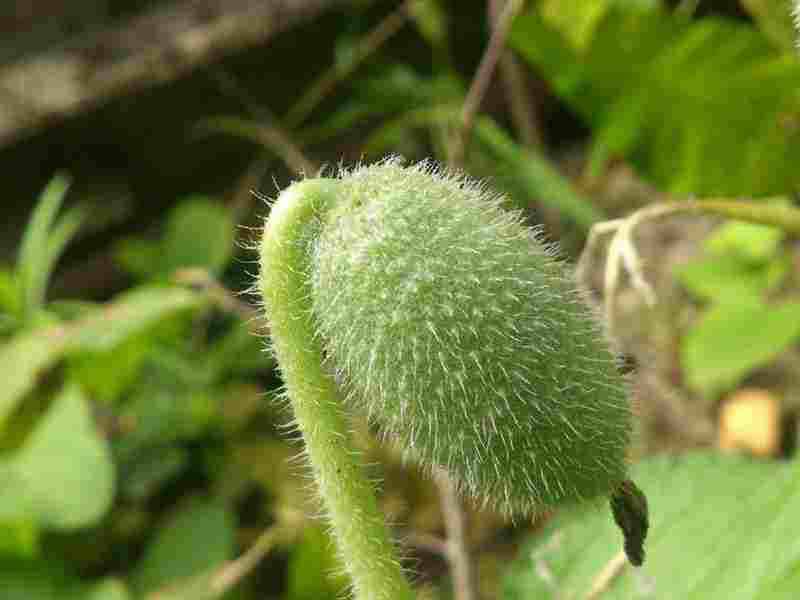

Useful Tips
Experienced gardeners give beginners some useful tips that will undoubtedly come in handy when cultivating this unusual plant:
- the plant is perfect for those people who want to create a beautiful hedge in just a few months; unlike perennial vines, wild cucumber needs to be planted annually, which allows you to abandon it at any opportunity;


- the liana of the plant forms a rather dense green carpet, so with its help you can hide those areas that should not be in plain sight;
- it is not recommended to eat the fruits of the plant without reading all the rules for collection and preparation, since they are poisonous;
- it is strictly forbidden to give cucumber fruits to children, even as a toy, as they can easily end up in a child's mouth, and, unfortunately, this will not do without consequences;
- when using the plant as a traditional medicine, it is imperative to consult with your doctor.
A photo of a mad cucumber plant shows all its beauty, for the sake of which it is planted by many gardeners - both professionals and amateurs.
Characteristics of varieties and hybrids of cucumbers with photos and descriptions
Before choosing a variety of cucumbers, read the photo and description of their characteristic features.
- Cucumbers on economically useful grounds are divided into salad and pickling and universal. Salad varieties are unsuitable for pickling, their fruits are consumed fresh. Pickled fruits retain dense crispy pulp in salted and canned form.
- In terms of ripening cucumbers are: early - come into fruiting at 38–45 days from germination, mid-early - at 46–50 days, mid-ripening - at 51–56 days and late-ripening - more than 56 days. It is advisable to sow 3-4 varieties in a mixture, differing in terms of ripening, in order to get fresh produce throughout the season.
- According to the method of pollination, varieties and hybrids are bee-pollinated and parthenocarpic. The first ones require pollinating insects, and if they are absent, then pollination should be carried out manually, otherwise there will be no harvest on these varieties. Parthenocarpic varieties do not need pollination, their fruits are formed without fertilization, but do not expect seeds from them either.
If it is indicated that the variety is parthenocarpic of the female type of flowering, it is necessary to plant a pollinator variety with it, otherwise it will bloom profusely, but you will get few fruits. In addition, parthenocarpic varieties are usually grown in greenhouses or film shelters. If they are pollinated by bees, they can produce twisted fruits. So refrain from growing these varieties outdoors unless there is an indication that they are suitable for this.
Parthenocarpic: Adam, Amazon, Anyuta, April, Aelita, White angel, Break, Cornflower, Vicenta, Voyage, Danila, Delpina, Dynamite, Emelya, Zozulya, Courage, Meadow, Makar, Marta, Navruz, Nastenka, Sail, Pasadena, Pasamonte, Picnic , Pyzhik, Romance, Russian style, Sapphire, Svyatoslav, September, Stella, Juventa, Julian, etc.
Bee-pollinated: Athlete, Hector, Hercules, Day, Druzhina, Unity, Crane, Salting, Table, Graceful, Casanova, Katyusha, Whale, Competitor, Swallow, Libelle, Pet, Maisky, Kid, Parade, Dude, Nugget, Slavic, Sunny, etc.
Here you should remember the golden rule: any cucumber for open ground grows well in greenhouses, however, not all greenhouse cucumbers are adapted to open ground. In open beds, hybrids are grown, adapted to the drying effect of the wind and low air humidity. In addition, in the event of pollination, green plants should not lose their commercial qualities. These requirements are met by such universal cultivation hybrids as parthenocarpic F1 Anyuta, F1 Buyan, F1 Ant, F1 Matryoshka, F1 Grasshopper, F1 Kozyrnaya karta, F1 Junior lieutenant, F1 Three tankers, parthenocarpic F1 Saltan, etc.
- Cucumbers differ significantly in light demand (shade tolerance).Most hybrids of the spring-summer growing period are light-loving forms that actively bear fruit in well-lit sunny areas. Light-loving hybrids are hybrids with a bundle arrangement of ovaries in the nodes. However, in some garden areas, dense plantings of fruit trees and shrubs create shading. In partial shade conditions, shade-tolerant hybrids are cultivated: bee-pollinated F1 Farmer, F1 Lord, parthenocarpic F1 Arina, F1 Mastak, F1 Moscow evenings, F1 Danila, F1 Classic, F1 October, F1 Pro. Of course, cucumbers of the spring-summer ecotype are grown in the summer. Winter cucumbers, despite their high shade tolerance, are inappropriate to plant in summer conditions, since, firstly, they are late ripening in terms of ripening, and secondly, winter hybrids will be affected by summer diseases (primarily downy mildew).
- From mid-August, the main limiting factor for the growth and fruiting of cucumber is low temperature, especially at night. In the morning, cold dew and condensation on the plastic wrap increase the hypothermia of plants, which leads to their physiological weakening, and an increase in susceptibility to diseases. In order to collect a large number of zelents in late summer - early autumn, cold-resistant cucumbers with a long fruiting period are planted (F1 Virenta, F1 Saltan, F1 Anyuta, F1 Boy with a finger, F1 Maryina Roscha, F1 Chistye prudy, F1 Moscow evenings, F1 Farmer, F1 Lord, etc.). It has been noticed that cold-resistant cucumbers are less affected by viral diseases.
- When choosing a variety of cucumbers, the characteristic of the duration of their fruiting is taken into account. If you need to get a high yield in a short period, early maturing sprinter hybrids are grown, which give most of the yield (9-16 kg / m2) in the first month of fruiting (F1 Regina-Plus, F1 Amur, F1 Bouquet). For collecting zelents, hybrids with an extended period of fruit formation have been used for a long time (F1 Anyuta, F1 Buyan, F1 Saltan, F1 Mazai, F1 Farmer, F1 Lord, etc.).
The duration of fruiting is associated with such a trait as branching (that is, the intensity of regrowth of side shoots). In some cases, preference is given to highly branching hybrids, in others - to weakly branching ones. Cucumbers with different types of branching are complementary, not mutually exclusive.
All summer cucumbers can be divided into 3 groups according to the nature of branching:
- hybrids with good branching;
- cucumber hybrids with moderate or limited branching; 3 - hybrids with weak branching.
1. Good branching is understood as the growth of lateral shoots from almost every node of the main stem; lateral shoots are long, requiring pinching in greenhouses. Many modern hybrids with good branching are characterized by a valuable trait - self-regulation of branching, when a high crop load on the main stem does not allow lateral shoots to form quickly (F1 Buyan, F1 Anyuta, F1 Boy with a finger, F1 Matryoshka, F1 Farmer, F1 Lord, F1 Maryina Roshcha , F1 Chistye Prudy, etc.). When most of the crop has been harvested from the main stem, the side shoots will begin to grow faster. This is especially important if you come to the garden on weekends - such plants do not have time to overgrow too much during the working week.
2. Hybrids with moderate branching of lateral shoots may have many, but they are not long, with shortened internodes. F1 Ant, F1 Grasshopper, F1 Trump card, F1 Mazai etc. combine limited shoot growth with a rather long fruiting period.
3. In cucumbers with weak branching of lateral shoots on the main stem, not very many, these shoots are shortened (i.e., determinate, with very short internodes), rapidly stopping their growth. These are cucumbers of the "bouquet" type - F1 Cupid, F1 Bouquet, F1 Regina-Plus.
The intensity of branching is genetically regulated, but it also depends on external conditions.With shade, low temperatures, drought, side shoots grow weaker, and in warm sunny weather with good watering, stronger.
Weakly branching hybrids are ideal for those cases when you need to get the maximum yield in a short time (3-4 weeks). The early yield of weakly branching cucumbers increases due to a denser planting (in greenhouses up to 5–6 plants / m2 instead of the usual 2.5–3 plants / m2). Hybrids with moderate (limited) branching are also well suited for harvesting within one month.
After the first, main, wave of fruiting on the main stem of a cucumber, a second wave of fruiting occurs on the lateral shoots. Therefore, if you want to collect greens for a longer time, you need to grow early ripening hybrids with more active branching. If the fruiting period lasts from 3-4 weeks to 1.5-2 months, opt for hybrids of the F1 Ant, F1 Grasshopper, F1 Kozyrnaya Karta, etc.
On open ridges, cucumbers are grown without forming (that is, without pinching the main stem and side shoots), therefore, growing lateral shoots are the key to long-term fruiting.
For pickling (and the best pickled cucumbers are obtained, as you know, with late harvests in August, since it is at this time that an increased sugar content accumulates in the greens) hybrids with moderate and good branching are suitable, they will provide you with a high yield at the end of summer - the beginning of autumn.
Cucumbers with a bundle arrangement of ovaries in knots are very popular. Such hybrids have high productivity, versatility of cultivation and excellent qualities of zelents. This group includes a large number of hybrids (F1 Buyan, F1 Saltan, F1 Anyuta, F1 True Friends, F1 Ant, F1 Maryina Roshcha, F1 Junior Lieutenant, F1 Three Tankmen, F1 Okhotny Ryad and many others).
Among bee-pollinated cucumbers, the forms of the female type of flowering (F1 Farmer, F1 Lord, F1 True Friends) are more productive in comparison with the forms of the mixed type. But for high-quality pollination, 10% of the pollinator must be sown to them or grown next to a hybrid or a cucumber variety that forms a large number of male flowers (barren flowers).
What else are we paying attention to? On the pubescence, or prickly, fruit. It is dense or almost absent, next to large thorns there may be small ones. And they differ in color: white, brown, black.
White-thorn cucumbers are of the salad type; they are not suitable for pickling. By the way, it is these vegetables that are supplied to our counters from greenhouses regardless of the season. Even on smooth, long fruits, rare white thorns can be discerned.
Black or brown thorns are a sign of a pickling or universal type of cucumber. Their fruits are good to eat fresh, pickle and pickle. The only drawback is that they overripe, turn yellow and become rough much faster than white-thorns. In Russia, cucumbers with a lumpy surface are loved, considering them "real". Europeans, on the other hand, prefer smooth ones. And those cucumbers that have “pimples” are called “Russian shirt” cucumbers.
These photos of cucumbers show plants of various varieties:
Chayote


This is a Mexican cucumber. For decorative purposes, it is often grown near gazebos and verandas. Support is required. The fruit tastes like zucchini, but is softer and sweeter. They are eaten fresh, boiled, stewed with other vegetables, pickled. The culture produces numerous edible tubers that taste like potatoes. From the stem after special processing. Various products are weaved, such as hats. Grown with seedlings. Loves light, abundant watering and feeding, the site must be protected from the wind.
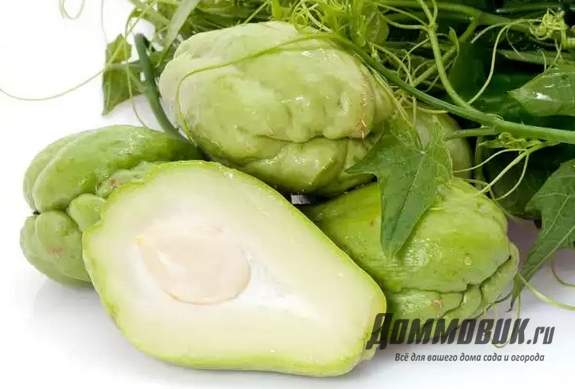

Distribution area
Crazy cucumber grows in many parts of the world. The area of its growth is Asia Minor, the Mediterranean.On the territory of Russia, the plant can be found in some regions of the Caucasus, Crimea, Krasnodar and Stavropol Territories. Indian pomegranate loves to grow in sandy soils where there is very little moisture. The places of its growth are roadsides, dry slopes of ravines.


Fertilizing cucumbers and how often to water vegetables in the greenhouse
Many novice vegetable growers are interested in how often to water cucumbers in a greenhouse in order to get a good harvest. The mode of irrigation of cucumber, a crop highly demanding to the conditions of the water regime and aeration of the soil, is differentiated depending on the lighting conditions. The irrigation rate in March - April is 4–6 liters, in May – June - 12–15 liters per 1 m² every other day or daily. Water the cucumber only with warm (20–25 ℃) water. Irrigation with cold water and waterlogging lead to the development of root rot, a sharp decrease in plant productivity.
The cucumber is fed depending on the growth period, the availability of nutrients in the soil and plants. Many gardeners prefer feeding cucumbers in the greenhouse with organic substances: a solution of mullein dilution 1: 4–8 or bird droppings 1: 10–12. Sometimes organic fertilizers are alternated with mineral fertilizers. The plants are fed immediately after harvest so that the absorbed minerals, especially nitrogen, have time to turn into organic compounds and do not cause the accumulation of nitrates.
Technology for growing cucumbers in a greenhouse: the formation of a bush
One of the important points in the technology of growing cucumbers in a greenhouse is the formation of a bush. The meaning of this is to ensure maximum yield due to the redistribution of photosynthetic products between plant organs, optimization of the illumination regime and the volume of the greenhouse.
For faster growth of the main stem and the formation of a powerful assimilation apparatus, female flowers and lateral lashes are removed at the lower 4 nodes, best of all in an embryonic state. In the next 1–2 nodes of the main stem, the ovaries are left, but the lateral lashes are removed. In the next nodes of the lower tier, the lateral shoots are pinched on 1-2 leaves, in the nodes of the middle tier - on 2 leaves, the top - on 2-3 leaves. The top of the plant is carefully wrapped around the trellis wire. If the greenhouse is low, then pinch the main stem shortly - above the 3-5th leaf.
In higher greenhouses, the top of the main lash is carefully wrapped around the trellis, lowered down and pinched at a height of 100 cm from the soil surface. This method is most often used for bee-pollinated cucumber plants. To ensure a longer fruiting period, as well as in some cases for parthenocarpic hybrids, the cucumber lashes are pinched over the 3-5th leaf above the trellis wire. When growing cucumbers, to form a bush from the upper nodes, one side shoot is lowered down, which is pinched after 50 cm, leaving an extension shoot up to a height of 100 cm from the ground level. On the horizontal section of the main stem, all shoots are removed to create better illumination.
The video of growing cucumbers in a greenhouse shows all stages of the technological process:
What is the use of it
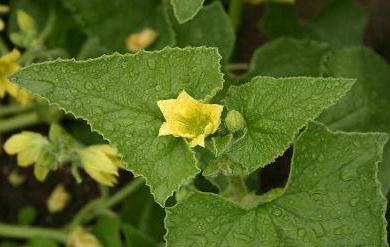

Crazy Cucumber is very poisonous. Neither the fruits nor any other parts of the plant can be eaten. Its flowers do not smell and are not honey-bearing. Nevertheless, it has been widely used since the time of Avicenna. The roots, stem and fruits of the plant contain a lot of steroids, alkaloids, vitamin C, carotenoids and other valuable substances. Thanks to them, preparations from mad cucumber are used in official and folk medicine for the treatment of many diseases. Outwardly, it is used for lichen, tumors, fungal diseases, non-healing ulcers, gout, hemorrhoids. Inside, decoctions are prescribed for those suffering from migraines, constipation, rheumatism, intestinal colic, cancer patients, people with hepatitis, diphtheria.
For medicinal purposes, the leaves and stems are harvested when the plant begins to bloom.Raw materials are dried in places where there is no direct sunlight, crushed. The roots are dug up in the fall, washed and also dried. First in the air, and then in the ovens. You can store finished raw materials for a year.
Echinocystist care recommendations
Echinocystis does not need a person at all. If you take care of him, then the hedge will turn out to be beautiful and harmonious. But if for some reason you cannot provide proper care for the prickly fruit, it will definitely not die from it. Yes, it will grow chaotically, but at the same time it will do it on its own. And I don't care what its location will be - a pitch shadow, an openwork partial shade or a place in the open sun.
In our country, mad cucumbers are grown as annual plants. With the onset of cold weather, it will be enough for you to cut off the dried ground part of the vine with a pruner, and to dig the garden bed on which it grew all summer long. The only thing the vine really needs is moisture. If you want your vertical landscaping to be beautiful, lush, and lush, water the exotic regularly. If you do not have time for watering, plant a prickly plant near an artificial or natural reservoir so that it can extract water from the ground on its own.
He will pay attention to the fact that after each watering it is advisable to loosen the soil in the bed with echinocystis. Otherwise, the damp earth will dry out under the influence of sunlight and become crusty. This will cause oxygen starvation of exotic and negatively affect the intensity of its growth.
Echinocystis, in principle, does not really need feeding. But if you have such an opportunity, it is still worth adding fertilizer to the soil. It is enough to do it twice, maximum - three times. The first time you can feed the plant with compost. And the second - chicken droppings. If there is a third time, feed the prickly carp with cow dung, but not fresh, but one that has lain for at least one year.
During the flowering period, the North American liana spreads its pleasant sweetish aroma everywhere. As a rule, many insects flock to it. Including useful ones. But keep in mind: planting a prickly fruit near cultivated plants is not worth it. Liana is able to strangle those who are weaker than her. Therefore, in order not to lose the harvest, place the flowerbed with the thorny fruit far from the garden beds and berry bushes.
Echinocystis is a danger to fruit trees. Some summer residents specially plant a vine near apple trees or plums in order to provide it with high-quality support. But the result is disastrous: it takes just a couple of years for a mad cucumber to crush a fruit tree. As a result, apple trees, pears and plums simply dry up.
Anguria
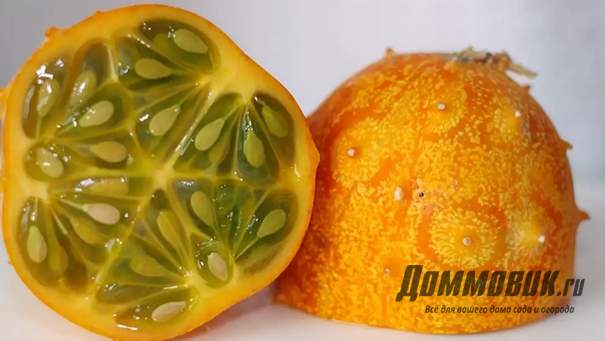

…… or else Antillean cucumber, Kiwano, horned melon. Vegetable and decorative annual liana with stems up to 4 m long, original leaves, similar to watermelon. Lush flowering, in place of flowers, cylindrical fruits up to 8 cm long, covered with fleshy thorns, are formed. Fruiting lasts until frost, Better to grow on a trellis. Young fruits are eaten raw and pickled. At a later age, the skin becomes dense, and they are inedible, instead they can be stored for a long time as souvenirs. Grown, like a cucumber, seedlings. The place is chosen sunny, well protected from the wind. The soil should be fertile, well-drained. The plant is very productive. For generous fruiting, as soon as the first ovary appears, pinch the tops of the shoots. There is also Syrian Anguria (Syrian cucumber) - a less potent vine with smaller fruits.
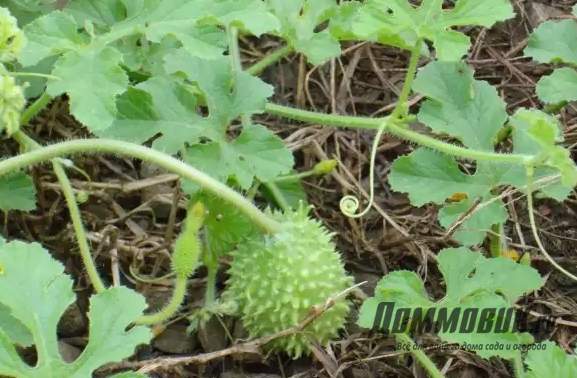

Appearance
The genus Mad cucumber belongs to This plant is one of a kind, its other species do not exist. You can meet it in Asia, the Mediterranean, in the south of Russia, in the Crimea, in the Caucasus, even on this cucumber is annual or perennial.Its stem represents a vine crawling on the ground or climbing supports. She has no antennae. Outwardly, our favorite vegetable and mad cucumber have a certain similarity. The photo clearly demonstrates. Its leaves are as wide and rough as that of an edible cucumber, the flowers are yellow, in the shape of a corolla. But the fruits resemble a real cucumber only remotely. They are ovate or oblong, up to 6 cm long, densely covered with bristles, very juicy at the beginning of maturity. Seeds are small, only 4 mm or less, slightly elongated, flat. In nature, this plant can be found in garbage heaps, landfills, along roadsides.


